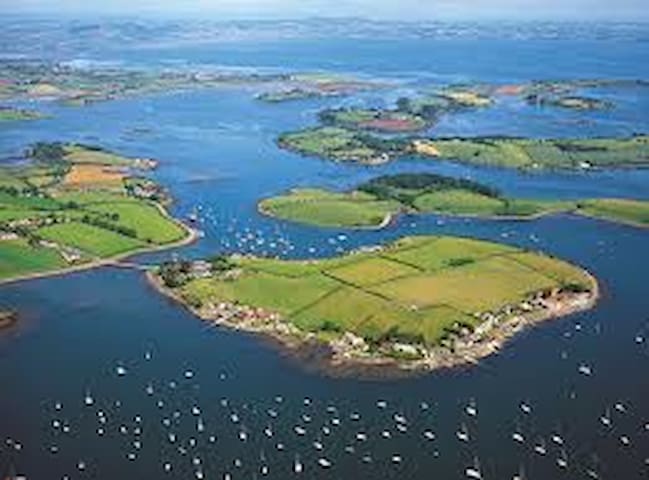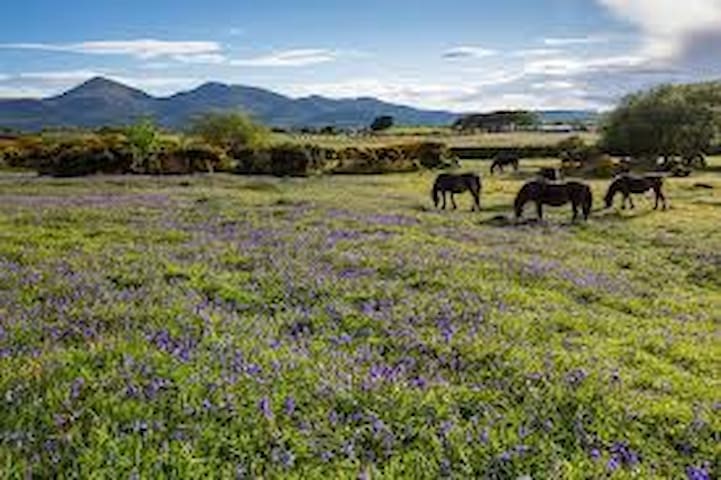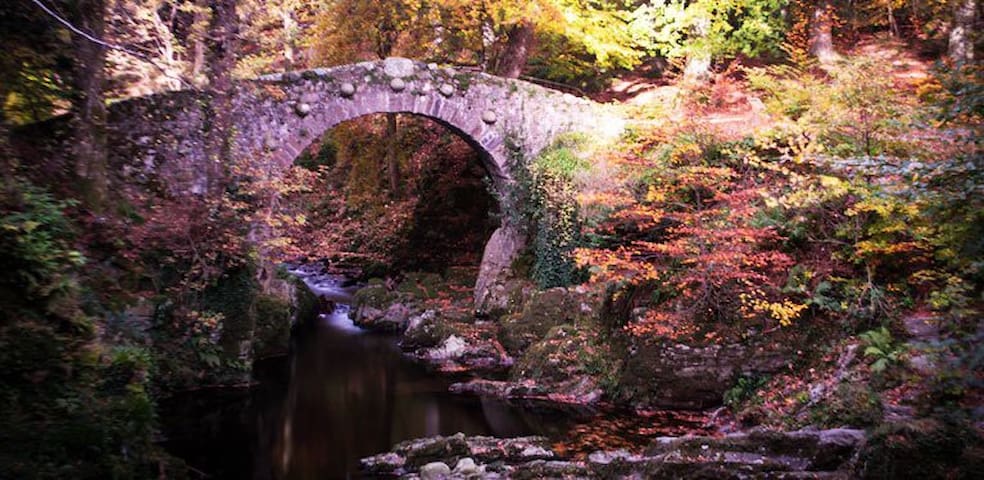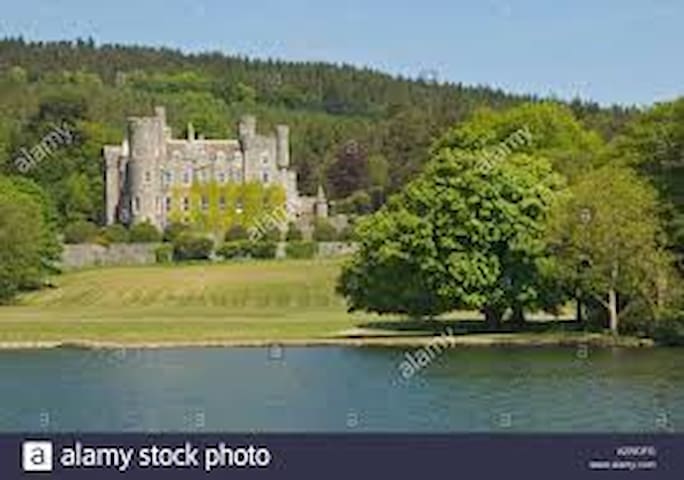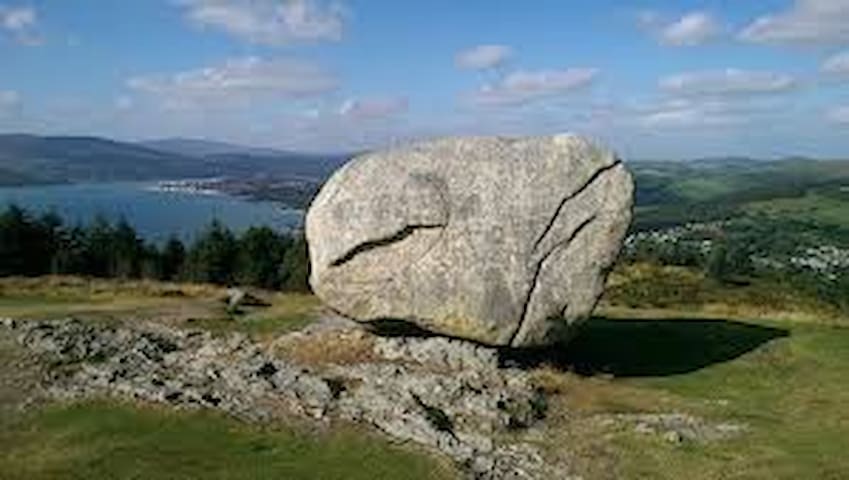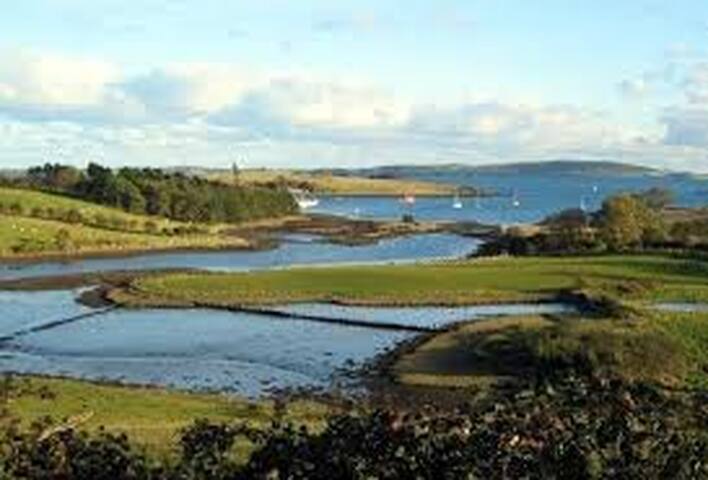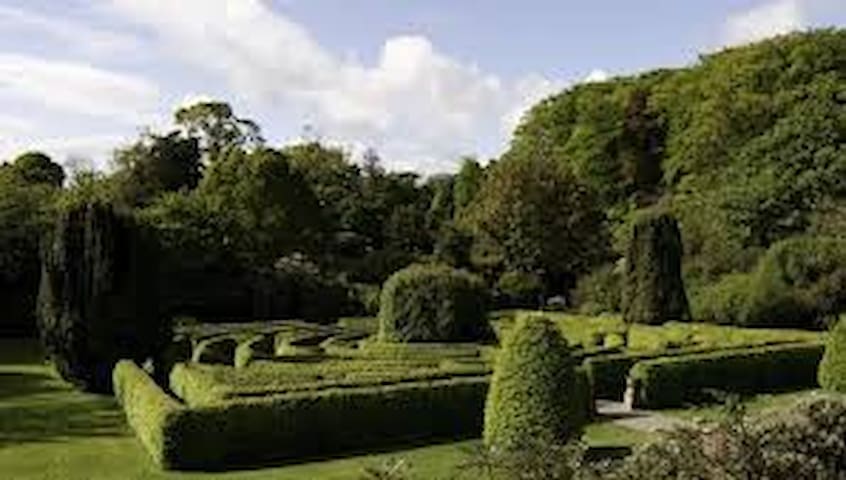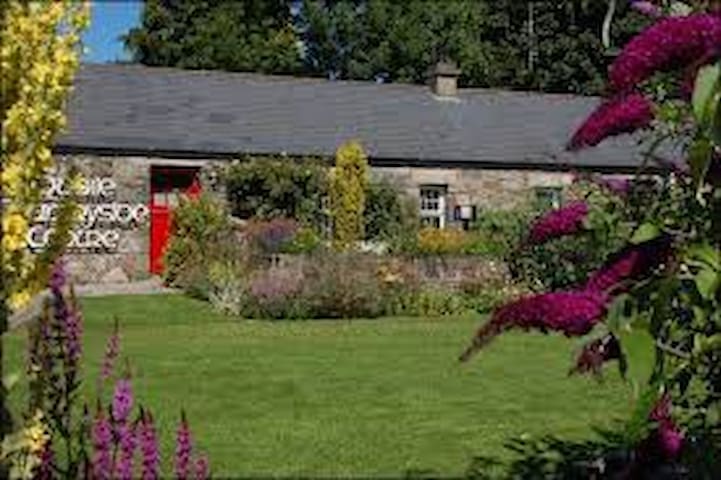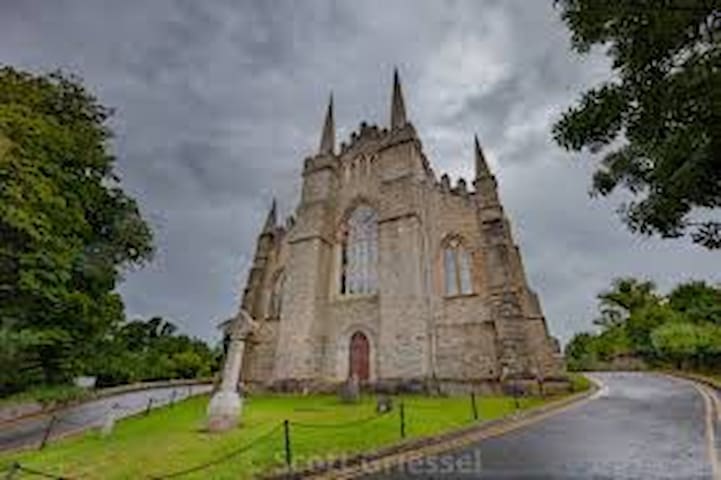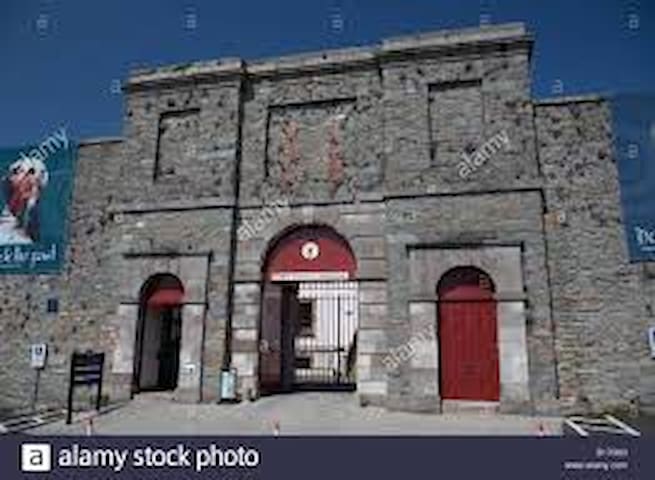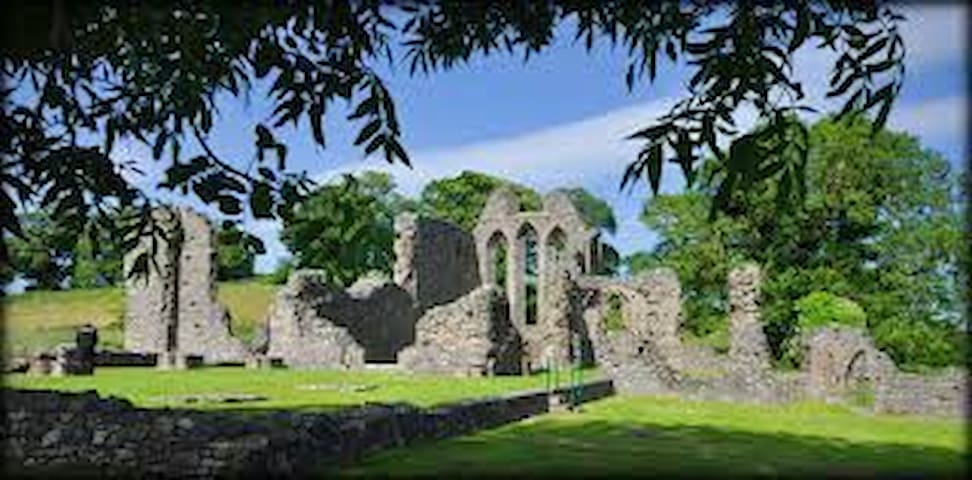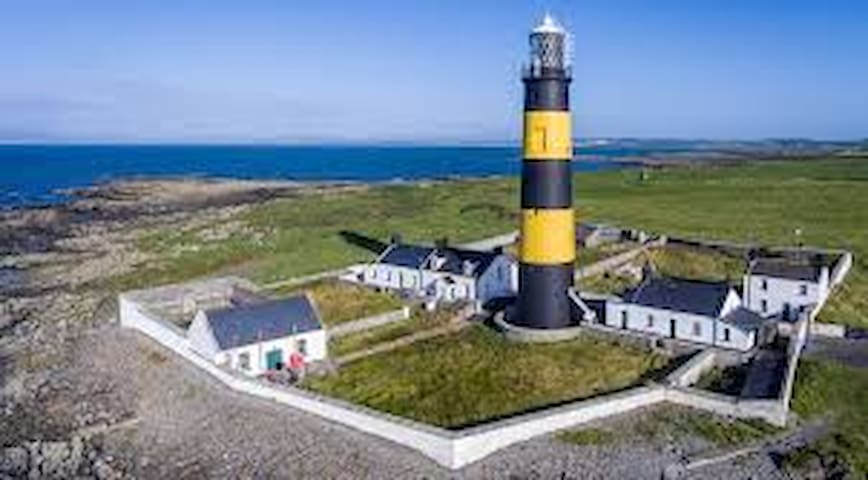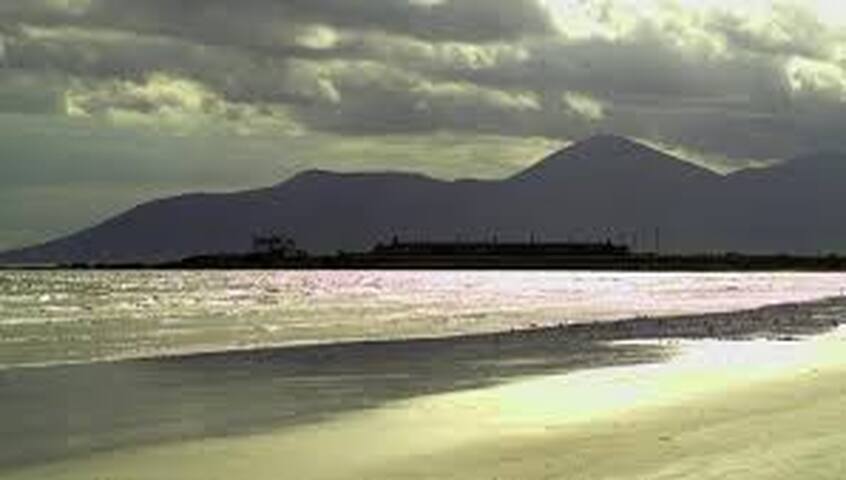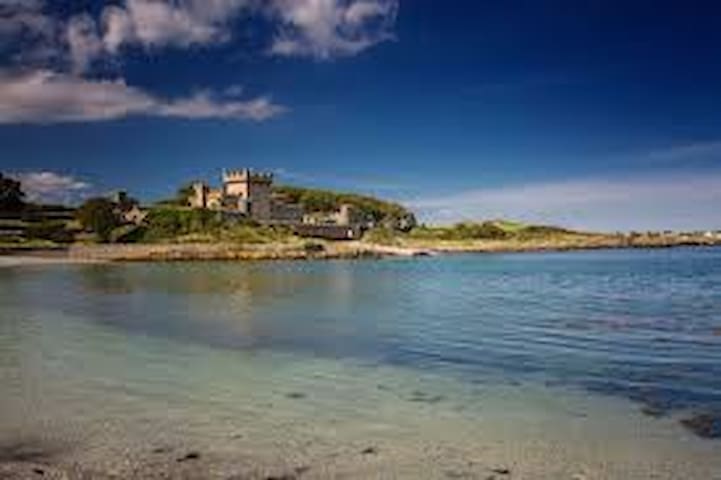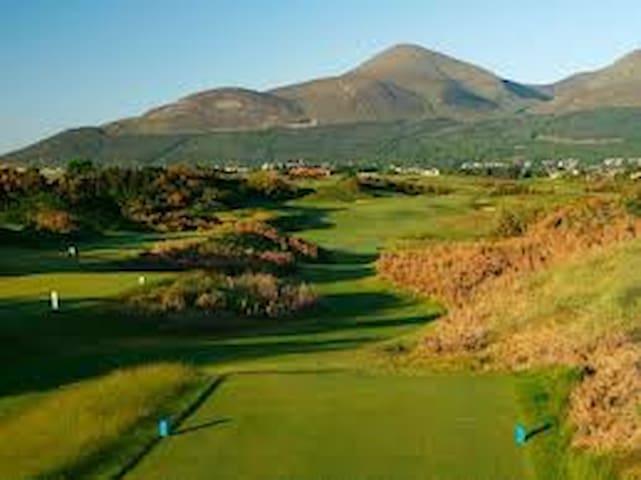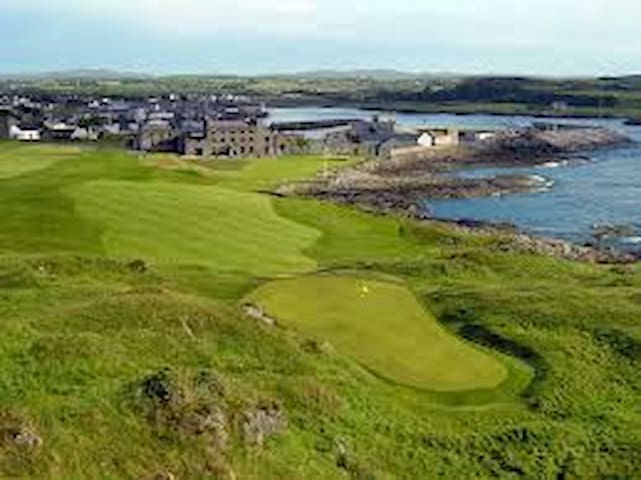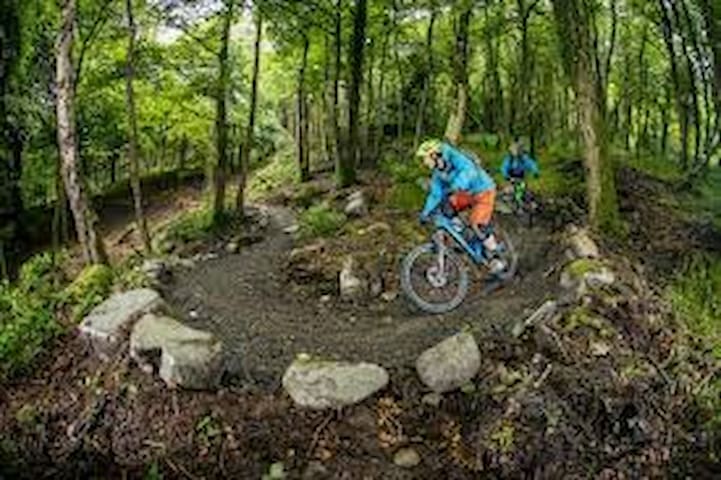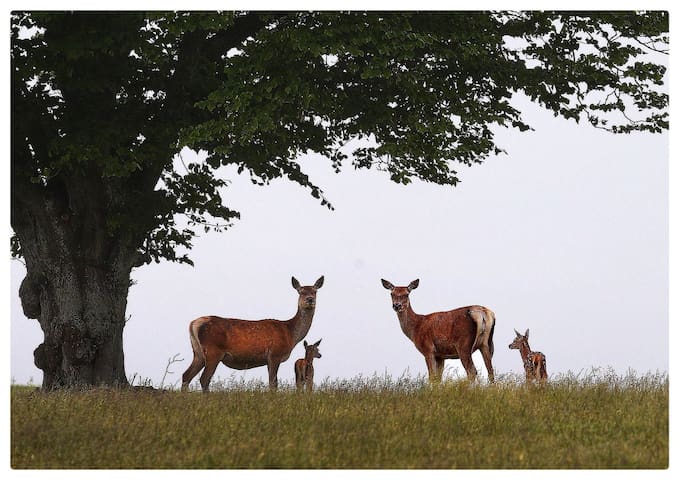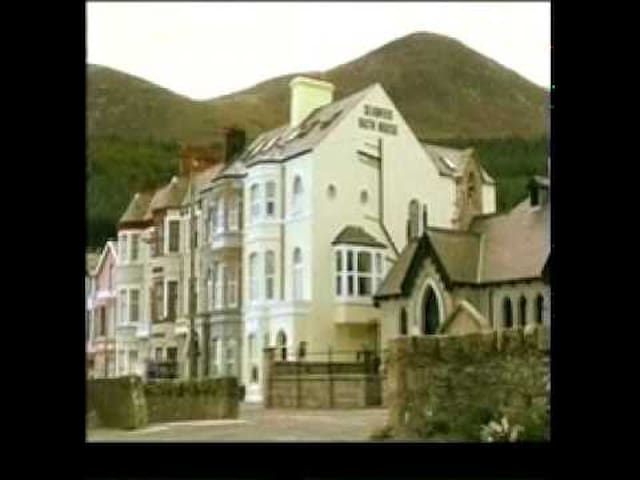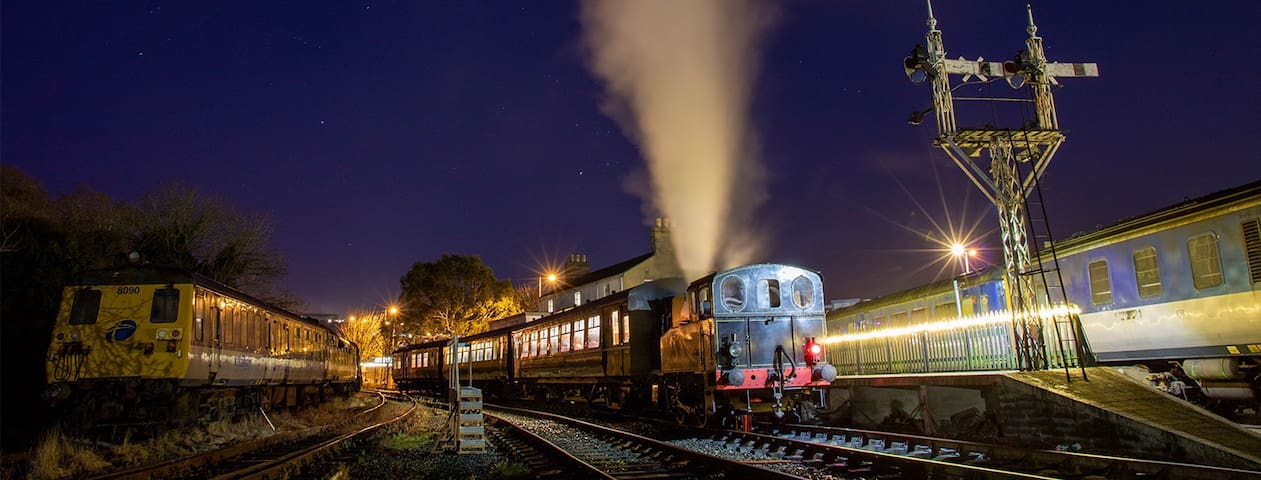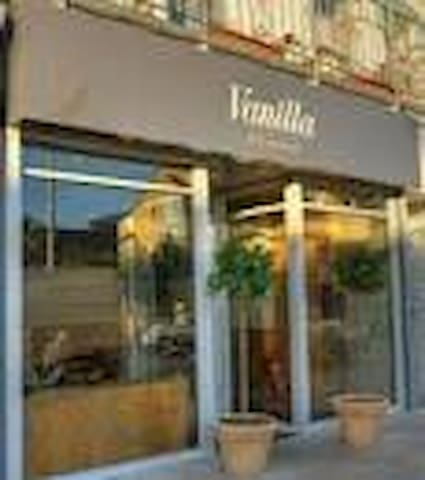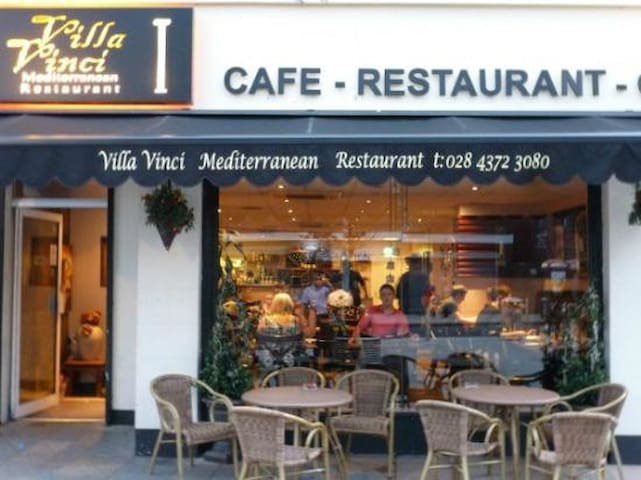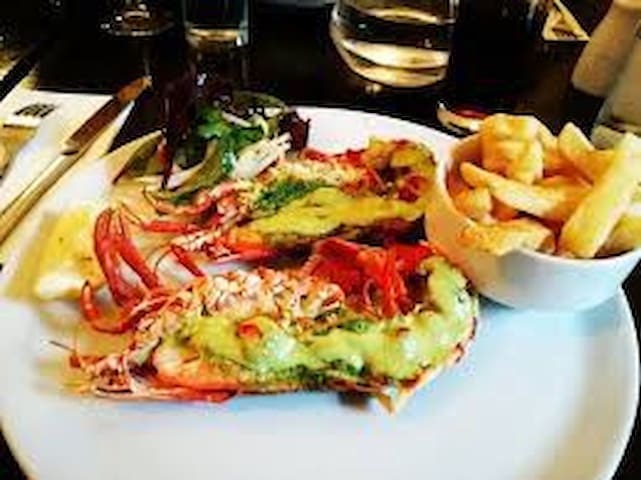Sightseeing & Walks
The Mourne Mountains are the highest and most dramatic mountain range in Northern Ireland with its summits crowned by granite. The mountains themselves are criss-crossed by an unrivalled network of paths and tracks.
The area was voted the ‘Best Walking Destination’ in Northern Ireland in Walk NI’s inaugural awards. The routes provide enthusiastic walkers with incredible opportunities for exploration.
The Mournes are divided into 2 very distinctive areas – the Eastern or ‘High’ Mournes and the Western or ‘Low’ Mournes. Any newcomer to the Mournes will be simply amazed at the variety of landscapes that can be encountered within such a confined geographical area.
The Mourne Wall, now a famous landmark running through the Mournes, was originally built in an effort to keep cattle and sheep out of the water catchment area of the Silent Valley reservoir.
Completed in 1922, it took over 18 years to complete with many skilled locals seasonally employed to build this stone wall which still stands up to 8ft high and 3ft wide. It is 22 miles (35.5km) in length and connects the summits of no less than 15 mountains in the Mournes, including Slieve Donard.
During the 18th and 19th Centuries illegal cargo ships stocked full of illicit packages of tobacco, wine, spirits, leather, silk and spices docked at the foot of the Mournes in Newcastle. Smugglers then loaded ponies with these illegal products and trekked through the Mourne Mountains to Hilltown.
Trade was so popular and the route so widely used that a track was soon created by the hooves of the heavily laden ponies. This old smugglers track still exists today and is used as a popular walking route, aptly know as “The Brandy Pad”.
Top 10 things to do in the Mournes
With spectacular and varied panoramas, the Mountains of Mourne are famous as a boundless natural playground within Northern Ireland’s great outdoors. Their clean air and beauty entices adventurers and relaxation seekers alike.
It’s just a beginning, but here are 10 of the top things you can get up to in the Mournes.
1. Scale the highest peak
Towering above Newcastle, the Irish Sea and the whole of Ulster, Slieve Donard is a premier hillwalking, hiking and mountaineering experience. Rise to the challenge of climbing the high point of the Mournes, and the rewards will be many. Pick a clear day and its summit will return truly unforgettable panoramas.
2. Find the Kingdom’s fairways
Indulge your golfing dreams in the Kingdom of Mourne. From Rory McIlroy’s favourites – world-class Royal County Down or his home club in Holywood – to the fantastic links of Ardglass, the parkland of Warrenpoint and the undulating greens at Kilkeel, the fairways just can’t get any better. And the nineteenths are pretty special too.
3. Lose yourself in Tollymore
Be it horse riding, gentle strolls, cycling, nature trailing or picnicking by the Shimna River, the magnificent Tollymore Forest Park is large enough and varied enough for it all. Tollymore is a special place where memories are made amid great beauty. It’s so good, HBO have used it several times for scenes in Game of Thrones.
4. Hear the silence in the valley
Breathe in the fresh mountain air and soak up the tranquillity that surrounds the liquid amphitheatre of Silent Valley. Follow the waterside through nature, heritage or challenge trails or take in the exhibition room explaining how the dam and reservoirs were built. An inspirational site for photographers, walkers and picnickers, the silence is golden all-year round.
5. Play the great outdoors
Calling all adrenalin junkies – the Mournes are rock climbing, coasteering, abseiling, mountain biking, kayaking and you-name-an-adventure central. Just hook up with one of the numerous local Adventure Providers, and dive, jump and drop your way through the best and most fun-filled mountain range in Northern Ireland. Mountain Biking at Castlewellan Forest Park and bouldering at Bloody Bridge are firm favourites in the area.
6. Ring the Peace Maze bell
Cycle, walk or horse-ride through the enchanting Castlewellan Forest Park, or solve your way to the centre of one of the world's largest permanent hedge mazes, and ring the bell to announce your achievement. Incredible views, one of Northern Ireland's most famous lakes, stunning castle and forest park, nature play and multi-activity centre – there’s everything here for the finest of days out.
7. Do the Murlough boardwalk
Wander the unique series of boardwalks that cross Murlough Nature Reserve, a fragile 6,000-year-old dune system backing the sensational Blue Flag beach at Murlough Bay. This spectacular location, with a Mournes backdrop, is excellent for peaceful strolls, wildlife watching and taking in the vibes of the Kingdom. Dundrum village is handy nearby for a spot of lunch or dinner.
8. Stop the world for spa
Melt into a full body massage, or try the facials, eye, back, hand and feet treatments and more at the Slieve Donard Resort & Spa. These luxurious pamper sessions come complete with stunning views across the Irish sea and the Mourne Mountains, swimming and vitality pools, and can even involve your own spa butler. Indulge, and bring your mind and body back into balance.
9. Microlight the Mournes
For the thrill of a lifetime, soar like an eagle over the Mournes in a Microlight Flight and marvel at the mind-blowing scenery below. Just sit back and take it all in, or take over the controls for a little while and assume the role of honorary pilot. Several local operators can have you airborne in no time.
10. Walk Slieve Gullion’s slopes
Reconnect with nature, history and mythology on the many walking routes south west of the Mournes in the beautiful volcanic landscape of the Ring of Gullion. With the dome of Slieve Gullion at its heart, there is terrain to suit all-comers. On the short red squirrel safari walk, two hides let you watch for the elusive species at monitored feeding stations.
Visit Walk NI website to get overview and recommended walks including:
Annalong Coastal Path
Bloody Bridge Coastal Route
Bloody Bridge River Walk
Blue Walk
Bunker's Hill Walk, Cycle and Play Trail
Castlewellan Forest Park - Annesley Garden Walk
Castlewellan Forest Park - Cypress Pond Park
Castlewellan Forest Park - Lakeside Walk
Castlewellan Forest Park - Moorish Tower Walk
Castlewellan Forest Park - Slievenaslat Walk
Central Mournes Cloughmore Trail Via Fiddler's Green
Donard Forest Walk
Drumee
Fairy Glen - Circular Walk
Glassdrummond Wood
Granite Trail (Bogie Line & Drinneevar Loop)
Granite Trail (Donard Loop & Bogie Line)
Hanna's Close - The Green Lane Walk
Hare's Gap
Hen, Cock and Pigeon Rock
Kilbroney Tree trail
Lough Shannagh
Meemore and Meelbeg
Montalto Estate Garden Walk
Montalto Estate Garden Walk
Montalto Estate Woodland Trail
Mourne Wall Challenge
Rostrevor - Cloughmore Stone
Rostrevor Views
Rostrevor to Newry
Saint Patrick's Way: The Pilgrims Walk
Scarva to Aughnacloy
Silent Valley Nature Trail
Slieve Binnian
Slieve Donard (Via Glen River)
Slieve Donard FRom Bloody Bridge
Slieve Donard, Commedagh and Bearnagh
The Giant's Lair Slieve Gullion
Tollymore Forest Parks - Mountains & Drinns Trail
Tollymore Forest Park - River Trail
Trassey to Bloody Bridge
127 Recomendado por los habitantes de la zona
Mourne Mountains
Moyad RoadThe Mourne Mountains are the highest and most dramatic mountain range in Northern Ireland with its summits crowned by granite. The mountains themselves are criss-crossed by an unrivalled network of paths and tracks.
The area was voted the ‘Best Walking Destination’ in Northern Ireland in Walk NI’s inaugural awards. The routes provide enthusiastic walkers with incredible opportunities for exploration.
The Mournes are divided into 2 very distinctive areas – the Eastern or ‘High’ Mournes and the Western or ‘Low’ Mournes. Any newcomer to the Mournes will be simply amazed at the variety of landscapes that can be encountered within such a confined geographical area.
The Mourne Wall, now a famous landmark running through the Mournes, was originally built in an effort to keep cattle and sheep out of the water catchment area of the Silent Valley reservoir.
Completed in 1922, it took over 18 years to complete with many skilled locals seasonally employed to build this stone wall which still stands up to 8ft high and 3ft wide. It is 22 miles (35.5km) in length and connects the summits of no less than 15 mountains in the Mournes, including Slieve Donard.
During the 18th and 19th Centuries illegal cargo ships stocked full of illicit packages of tobacco, wine, spirits, leather, silk and spices docked at the foot of the Mournes in Newcastle. Smugglers then loaded ponies with these illegal products and trekked through the Mourne Mountains to Hilltown.
Trade was so popular and the route so widely used that a track was soon created by the hooves of the heavily laden ponies. This old smugglers track still exists today and is used as a popular walking route, aptly know as “The Brandy Pad”.
Top 10 things to do in the Mournes
With spectacular and varied panoramas, the Mountains of Mourne are famous as a boundless natural playground within Northern Ireland’s great outdoors. Their clean air and beauty entices adventurers and relaxation seekers alike.
It’s just a beginning, but here are 10 of the top things you can get up to in the Mournes.
1. Scale the highest peak
Towering above Newcastle, the Irish Sea and the whole of Ulster, Slieve Donard is a premier hillwalking, hiking and mountaineering experience. Rise to the challenge of climbing the high point of the Mournes, and the rewards will be many. Pick a clear day and its summit will return truly unforgettable panoramas.
2. Find the Kingdom’s fairways
Indulge your golfing dreams in the Kingdom of Mourne. From Rory McIlroy’s favourites – world-class Royal County Down or his home club in Holywood – to the fantastic links of Ardglass, the parkland of Warrenpoint and the undulating greens at Kilkeel, the fairways just can’t get any better. And the nineteenths are pretty special too.
3. Lose yourself in Tollymore
Be it horse riding, gentle strolls, cycling, nature trailing or picnicking by the Shimna River, the magnificent Tollymore Forest Park is large enough and varied enough for it all. Tollymore is a special place where memories are made amid great beauty. It’s so good, HBO have used it several times for scenes in Game of Thrones.
4. Hear the silence in the valley
Breathe in the fresh mountain air and soak up the tranquillity that surrounds the liquid amphitheatre of Silent Valley. Follow the waterside through nature, heritage or challenge trails or take in the exhibition room explaining how the dam and reservoirs were built. An inspirational site for photographers, walkers and picnickers, the silence is golden all-year round.
5. Play the great outdoors
Calling all adrenalin junkies – the Mournes are rock climbing, coasteering, abseiling, mountain biking, kayaking and you-name-an-adventure central. Just hook up with one of the numerous local Adventure Providers, and dive, jump and drop your way through the best and most fun-filled mountain range in Northern Ireland. Mountain Biking at Castlewellan Forest Park and bouldering at Bloody Bridge are firm favourites in the area.
6. Ring the Peace Maze bell
Cycle, walk or horse-ride through the enchanting Castlewellan Forest Park, or solve your way to the centre of one of the world's largest permanent hedge mazes, and ring the bell to announce your achievement. Incredible views, one of Northern Ireland's most famous lakes, stunning castle and forest park, nature play and multi-activity centre – there’s everything here for the finest of days out.
7. Do the Murlough boardwalk
Wander the unique series of boardwalks that cross Murlough Nature Reserve, a fragile 6,000-year-old dune system backing the sensational Blue Flag beach at Murlough Bay. This spectacular location, with a Mournes backdrop, is excellent for peaceful strolls, wildlife watching and taking in the vibes of the Kingdom. Dundrum village is handy nearby for a spot of lunch or dinner.
8. Stop the world for spa
Melt into a full body massage, or try the facials, eye, back, hand and feet treatments and more at the Slieve Donard Resort & Spa. These luxurious pamper sessions come complete with stunning views across the Irish sea and the Mourne Mountains, swimming and vitality pools, and can even involve your own spa butler. Indulge, and bring your mind and body back into balance.
9. Microlight the Mournes
For the thrill of a lifetime, soar like an eagle over the Mournes in a Microlight Flight and marvel at the mind-blowing scenery below. Just sit back and take it all in, or take over the controls for a little while and assume the role of honorary pilot. Several local operators can have you airborne in no time.
10. Walk Slieve Gullion’s slopes
Reconnect with nature, history and mythology on the many walking routes south west of the Mournes in the beautiful volcanic landscape of the Ring of Gullion. With the dome of Slieve Gullion at its heart, there is terrain to suit all-comers. On the short red squirrel safari walk, two hides let you watch for the elusive species at monitored feeding stations.
Visit Walk NI website to get overview and recommended walks including:
Annalong Coastal Path
Bloody Bridge Coastal Route
Bloody Bridge River Walk
Blue Walk
Bunker's Hill Walk, Cycle and Play Trail
Castlewellan Forest Park - Annesley Garden Walk
Castlewellan Forest Park - Cypress Pond Park
Castlewellan Forest Park - Lakeside Walk
Castlewellan Forest Park - Moorish Tower Walk
Castlewellan Forest Park - Slievenaslat Walk
Central Mournes Cloughmore Trail Via Fiddler's Green
Donard Forest Walk
Drumee
Fairy Glen - Circular Walk
Glassdrummond Wood
Granite Trail (Bogie Line & Drinneevar Loop)
Granite Trail (Donard Loop & Bogie Line)
Hanna's Close - The Green Lane Walk
Hare's Gap
Hen, Cock and Pigeon Rock
Kilbroney Tree trail
Lough Shannagh
Meemore and Meelbeg
Montalto Estate Garden Walk
Montalto Estate Garden Walk
Montalto Estate Woodland Trail
Mourne Wall Challenge
Rostrevor - Cloughmore Stone
Rostrevor Views
Rostrevor to Newry
Saint Patrick's Way: The Pilgrims Walk
Scarva to Aughnacloy
Silent Valley Nature Trail
Slieve Binnian
Slieve Donard (Via Glen River)
Slieve Donard FRom Bloody Bridge
Slieve Donard, Commedagh and Bearnagh
The Giant's Lair Slieve Gullion
Tollymore Forest Parks - Mountains & Drinns Trail
Tollymore Forest Park - River Trail
Trassey to Bloody Bridge
The Silent Valley Reservoir was built to gather water from the Mourne Mountains and is the main water supply source for most of County Down and a large part of Belfast.
Ringed by mountains, 'The Valley', located within the Mourne Area of Outstanding Natural Beauty, houses beautiful parkland, lakes and a pond. It attracts around 50,000 visitors per year most of whom come to enjoy the peace and solitude of this mountain area with its unique landscapes and varied wildlife.
Northern Ireland Water has provided a number of visitor facilities at the site including an information centre, conference centre and education centre - all housed in two old colonial style bungalows and enjoying delightful views over the parkland.
Three new walking routes within the Silent Valley were launched in 2014: the all-ability loop, the reservoir loop and the viewpoint loop. These demonstrate the history and heritage of the site, such as the Mourne Wall and the Binnian Tunnell.
The famous Mourne Wall was constructed to enclose the reservoir's catchment area, built between 1904 and 1922 by the Belfast Water Commissioners.
The wall was crafted from natural granite stone using traditional dry stone walling techniques. On average the wall is about 1.5 metres high and 0.8 to 0.9 metres thick. It is 22 miles (35 km) long and passes over fifteen of the Mourne's summits. Many walkers use the wall as a marker.
35 Recomendado por los habitantes de la zona
Silent Valley Reservoir
The Silent Valley Reservoir was built to gather water from the Mourne Mountains and is the main water supply source for most of County Down and a large part of Belfast.
Ringed by mountains, 'The Valley', located within the Mourne Area of Outstanding Natural Beauty, houses beautiful parkland, lakes and a pond. It attracts around 50,000 visitors per year most of whom come to enjoy the peace and solitude of this mountain area with its unique landscapes and varied wildlife.
Northern Ireland Water has provided a number of visitor facilities at the site including an information centre, conference centre and education centre - all housed in two old colonial style bungalows and enjoying delightful views over the parkland.
Three new walking routes within the Silent Valley were launched in 2014: the all-ability loop, the reservoir loop and the viewpoint loop. These demonstrate the history and heritage of the site, such as the Mourne Wall and the Binnian Tunnell.
The famous Mourne Wall was constructed to enclose the reservoir's catchment area, built between 1904 and 1922 by the Belfast Water Commissioners.
The wall was crafted from natural granite stone using traditional dry stone walling techniques. On average the wall is about 1.5 metres high and 0.8 to 0.9 metres thick. It is 22 miles (35 km) long and passes over fifteen of the Mourne's summits. Many walkers use the wall as a marker.
At 150 km² Strangford Lough is the largest sea Lough in the British Isles and is a haven for wildlife. Strangford Lough’s shores are also home to some of the finest country estates, parklands and walking trails in Northern Ireland. There is something for every walker to enjoy but the trails are especially suited to families and those looking for well-signed scenic outings on good surfaces. The Lecale Way is the iconic long distance coastal walk in this area.
The coastline around Strangford Lough is dotted with tower-house castles built by noble Norman families. At Ardglass you can find six castles in the town. The area also has many hilltops with windmill stumps, the one above Portaferry offers an excellent vantage point over the Narrows and Lecale to the Mourne Mountains while the one at Ballycopeland has been fully restored. The number of estates on the shore have in many instances been used as film locations. Most recently Castle Ward has been used as the backdrop for Winterfell in Game of Thrones® and Mount Stewart in Dracula Untold.
The Lecale Way is part of the Ulster Way tying Downpatrick, Strangford, Ardglass together in a mix of cross country trails and coastal paths. The route passes many parts including Struell Wells, Saul, Castle Ward, and Strangford where you may board Europe’s oldest ferry service dating back to 1180. The Ballyhornan Coastal Path leads to Ardglass and Saint John’s Point where you find Ireland’s tallest onshore lighthouse. It continues on to Ballykinlar finishing at Newcastle having passed through Dundrum.
Visit Walk NI website to get overview and recommended walks including:
Ballyquintin Farm, Bar Hall Bay Trail
Ballyquintin Farm NationalNature Reserve Trail
Ballyquintin Port Kelly Trail
Castle Ward Boundary Trail
Castle Ward Castle Trail
Castleward Farm Trail
Castleward Shore Trail
Corrog Wood
Delamont Corbally Walk
Delamont Garden Walk
Delamont Long Walk
Delamont Mullagh Walk
Delamont Strangford Walk
Kearney
Killard National Nature Reserve
Lecale Way
Quoile River Walk
Tober Mhuire Heritage Trail
15 Recomendado por los habitantes de la zona
Strangford Lough
At 150 km² Strangford Lough is the largest sea Lough in the British Isles and is a haven for wildlife. Strangford Lough’s shores are also home to some of the finest country estates, parklands and walking trails in Northern Ireland. There is something for every walker to enjoy but the trails are especially suited to families and those looking for well-signed scenic outings on good surfaces. The Lecale Way is the iconic long distance coastal walk in this area.
The coastline around Strangford Lough is dotted with tower-house castles built by noble Norman families. At Ardglass you can find six castles in the town. The area also has many hilltops with windmill stumps, the one above Portaferry offers an excellent vantage point over the Narrows and Lecale to the Mourne Mountains while the one at Ballycopeland has been fully restored. The number of estates on the shore have in many instances been used as film locations. Most recently Castle Ward has been used as the backdrop for Winterfell in Game of Thrones® and Mount Stewart in Dracula Untold.
The Lecale Way is part of the Ulster Way tying Downpatrick, Strangford, Ardglass together in a mix of cross country trails and coastal paths. The route passes many parts including Struell Wells, Saul, Castle Ward, and Strangford where you may board Europe’s oldest ferry service dating back to 1180. The Ballyhornan Coastal Path leads to Ardglass and Saint John’s Point where you find Ireland’s tallest onshore lighthouse. It continues on to Ballykinlar finishing at Newcastle having passed through Dundrum.
Visit Walk NI website to get overview and recommended walks including:
Ballyquintin Farm, Bar Hall Bay Trail
Ballyquintin Farm NationalNature Reserve Trail
Ballyquintin Port Kelly Trail
Castle Ward Boundary Trail
Castle Ward Castle Trail
Castleward Farm Trail
Castleward Shore Trail
Corrog Wood
Delamont Corbally Walk
Delamont Garden Walk
Delamont Long Walk
Delamont Mullagh Walk
Delamont Strangford Walk
Kearney
Killard National Nature Reserve
Lecale Way
Quoile River Walk
Tober Mhuire Heritage Trail
Murlough National Nature Reserve is a fragile 6000 year old sand dune system owned by the National Trust and managed as Ireland’s first Nature Reserve since 1967.
It is an excellent area for walking and bird watching due to its spectacular location at the edge of Dundrum Bay and the Mourne Mountains.
It offers the best and most extensive example of dune heath within Ireland, a network of paths and boardwalks through the dunes, woodland and heath with an array of butterflies and wild flowers. One of 22 butterfly species, the Marsh Fritillary, is of European importance. The reserve is internationally important for wintering wildfowl and waders as well as a haul-out site for Common and Grey seals.
There is evidence of human habitation from Neolithic times, through the Bronze Age to the present day and access to one of the finest beaches in County Down, complete with stunning panoramic views of the Mountains of Mourne sweeping down to the sea. There is a self-guided nature walk and additional guided walks and volunteer events throughout the year.
The Trust maintains coastal and mountain paths for hikers to Slieve Donard, Northern Ireland’s much loved highest mountain, and neighbouring Slieve Commedagh. The walks offer spectacular scenery and access up to the Mourne Wall and into the Inner Mournes. The Mourne Coastal Footpath stretches for a mile and a half south of the historic site of Bloody Bridge. From Bloody Bridge you can follow the intriguingly named Brandy Pad, an ancient smuggler’s route from the shore into the heart of the mountains.
There are 1300 acres of upland, comprised principally of dry and wet heath and acid grasslands, home to rare montane lichen communities.
Visitor facilities include – Nature reserve, coast, country walk, access for visitors with disabilities, suitable for picnics, learning opportunities. Dogs welcome on leads.
10 Recomendado por los habitantes de la zona
National Trust - Murlough National Nature Reserve
Keel PointMurlough National Nature Reserve is a fragile 6000 year old sand dune system owned by the National Trust and managed as Ireland’s first Nature Reserve since 1967.
It is an excellent area for walking and bird watching due to its spectacular location at the edge of Dundrum Bay and the Mourne Mountains.
It offers the best and most extensive example of dune heath within Ireland, a network of paths and boardwalks through the dunes, woodland and heath with an array of butterflies and wild flowers. One of 22 butterfly species, the Marsh Fritillary, is of European importance. The reserve is internationally important for wintering wildfowl and waders as well as a haul-out site for Common and Grey seals.
There is evidence of human habitation from Neolithic times, through the Bronze Age to the present day and access to one of the finest beaches in County Down, complete with stunning panoramic views of the Mountains of Mourne sweeping down to the sea. There is a self-guided nature walk and additional guided walks and volunteer events throughout the year.
The Trust maintains coastal and mountain paths for hikers to Slieve Donard, Northern Ireland’s much loved highest mountain, and neighbouring Slieve Commedagh. The walks offer spectacular scenery and access up to the Mourne Wall and into the Inner Mournes. The Mourne Coastal Footpath stretches for a mile and a half south of the historic site of Bloody Bridge. From Bloody Bridge you can follow the intriguingly named Brandy Pad, an ancient smuggler’s route from the shore into the heart of the mountains.
There are 1300 acres of upland, comprised principally of dry and wet heath and acid grasslands, home to rare montane lichen communities.
Visitor facilities include – Nature reserve, coast, country walk, access for visitors with disabilities, suitable for picnics, learning opportunities. Dogs welcome on leads.
The Quoile Pondage National Nature Reserve is situated just outside Downpatrick on either side of the Quoile River. It was created in 1957 by the construction of a tidal barrier to prevent flooding in the Downpatrick area. Soon after the barrier was built, plants and trees colonised the former seashore. Facilities at the reserve include the Quoile Countryside Centre with displays on the wildlife and history of the area. There are also many features of historical interest within the reserve including Quoile Quay situated close to the Centre, which itself is just beside Quoile Castle.
See also
8 Recomendado por los habitantes de la zona
Quoile River
The Quoile Pondage National Nature Reserve is situated just outside Downpatrick on either side of the Quoile River. It was created in 1957 by the construction of a tidal barrier to prevent flooding in the Downpatrick area. Soon after the barrier was built, plants and trees colonised the former seashore. Facilities at the reserve include the Quoile Countryside Centre with displays on the wildlife and history of the area. There are also many features of historical interest within the reserve including Quoile Quay situated close to the Centre, which itself is just beside Quoile Castle.
See also
Slieve Croob or, 'Mountain of the Hoof' rises to a height of 1,755 feet, its chief claim to fame being the source of the River Lagan which rises a short distance from the summit. Superior views of the high Mournes are to be seen from the summit, but the best view point is from Windy Gap.
A walk, taking in Slieve Croob (The Twelve Cairns), part of the Dromara hills, starts at the Dree Hill car park (J300453). Leave car park and turn right onto Dree Hill road, follow the road down to Finnis. At Finnis take the road on the right - Drin Road. Follow this for about 1.5km (1 mile) and opposite No. 66 take the concrete lane on the right - known as ‘The Pass Loaning.’ This gives access to the northern slopes of Slieve Croob. On the hill follow waymarkers. On meeting the surfaced Transmitter Road either turn left to enjoy the view from the summit or right to return back to the car park.
7 Recomendado por los habitantes de la zona
Slieve Croob
Slieve Croob or, 'Mountain of the Hoof' rises to a height of 1,755 feet, its chief claim to fame being the source of the River Lagan which rises a short distance from the summit. Superior views of the high Mournes are to be seen from the summit, but the best view point is from Windy Gap.
A walk, taking in Slieve Croob (The Twelve Cairns), part of the Dromara hills, starts at the Dree Hill car park (J300453). Leave car park and turn right onto Dree Hill road, follow the road down to Finnis. At Finnis take the road on the right - Drin Road. Follow this for about 1.5km (1 mile) and opposite No. 66 take the concrete lane on the right - known as ‘The Pass Loaning.’ This gives access to the northern slopes of Slieve Croob. On the hill follow waymarkers. On meeting the surfaced Transmitter Road either turn left to enjoy the view from the summit or right to return back to the car park.
Walks & Activities
For the student of garden follies, Tollymore is a rare treat. A barn dressed up to look like a church, stone cones atop gate piers and gothic-style gate arches all show the influence of that highly individualistic designer, Thomas Wright of Durham (1711-1786), who was a friend of Lord Clanbrassil, owner of Tollymore at that time.
A walk along the Shimna river is marked by many curiosities, natural and artificial - rocky outcrops, bridges, grottos and caves. Elsewhere in the park the tree lover can examine experimental forest plots - some of exotic trees such as monkey puzzle and eucalyptus - or admire the tall giant redwoods and Monterey pines. Oak wood from Tollymore was the preferred material for the interiors of the White Star liners including the 'Titanic' which was built in Belfast. Seek out the original tree of the slow-growing spruce, Picea abies 'Clanbrassiliana' which originated nearby in about 1750 and is the oldest tree in any arboretum in Ireland. A magnificent avenue of Deodar cedars is a striking feature of the entrance to this romantic forest park in the foothills of the Mourne Mountains.
97 Recomendado por los habitantes de la zona
Tollymore Forest Park
Bryansford RoadFor the student of garden follies, Tollymore is a rare treat. A barn dressed up to look like a church, stone cones atop gate piers and gothic-style gate arches all show the influence of that highly individualistic designer, Thomas Wright of Durham (1711-1786), who was a friend of Lord Clanbrassil, owner of Tollymore at that time.
A walk along the Shimna river is marked by many curiosities, natural and artificial - rocky outcrops, bridges, grottos and caves. Elsewhere in the park the tree lover can examine experimental forest plots - some of exotic trees such as monkey puzzle and eucalyptus - or admire the tall giant redwoods and Monterey pines. Oak wood from Tollymore was the preferred material for the interiors of the White Star liners including the 'Titanic' which was built in Belfast. Seek out the original tree of the slow-growing spruce, Picea abies 'Clanbrassiliana' which originated nearby in about 1750 and is the oldest tree in any arboretum in Ireland. A magnificent avenue of Deodar cedars is a striking feature of the entrance to this romantic forest park in the foothills of the Mourne Mountains.
Located in a dramatic setting of mountains and sea, this is one of the most outstanding tree and shrub collections in Europe. The beauty, vigour and perfect shape of the trees in the National Arboretum attract tree enthusiasts from around the world. However, Castlewellan has numerous features that draw wider attention. The garden is a mixture of informal and formal design with terraces, fountains, ornamental gates and flower borders. To walk around the forest park's mile-long lake, encountering some intriguing modern sculptures on the way, is to enjoy a great experience of eighteenth-century landscaping.
The planting of the walled Annesley garden, the focus of the arboretum, was begun in the 1850s and rare conifers and maples were later imported directly from Japan. Then came the addition of more rich varieties, including Chilean eucryphias, Australian athrotaxis and pittosporum and Chinese rhododendrons. The arboretum holds many trees with record heights in the British Isles.
One of Northern Ireland's most famous lakes, a stunning Victorian Castle, incredible panoramic views, scenic walking trails, 27km of Mountain Bike Trails, Nature Play perfect for the kids, an onsite multi-activity centre, hedge maze and equestrian centre, Castlewellan Forest Park boasts all of this and more making it a must-visit for all ages.
Play Structure
Perfect for the kids, a brand new play structure has recently been installed in the forest park. ‘Animal Wood’ is designed for four to eleven year olds' and is located beside the Peace Maze. Featuring a short path, Animal Wood provides lots of opportunities for playing on wild woodland animals including a badger and its den, a red squirrel and a giant spider. In addition it boasts a wooden play structure with a tower in the image of The Moorish Tower where children can enjoy the climbing wall, fireman’s pole and rope-bridge over to a hollow tree stump slide and Red Kite nest that are sure to keep the kids entertained! Check out our blog 'Kids Go Wild for Nature Play' for one families first hand account of the play area.
Peaze Maze
Beside ‘Animal Wood’ you’ll find the Peace Maze, one of the world's largest permanent hedge mazes representing the path to a peaceful future for Northern Ireland. Planted in 2000 with community involvement, visitors can attempt to solve their way to the peace bell in the centre of the maze.
Access
Access available for people with limited mobility on scooter. Manual wheelchairs - the total distance including the Peace Maze and Gardens is around 6 miles and would recommend a challenge to any pushers at any one visit.
Walking Trails
Slievenaslat Walk 2.7 miles
Moorish Tower Walk 3.2. miles
Lakeside Walk 2.4 miles
Annesley Garden Walk 2.2 miles
Cypress Pond Walk 3.1 miles
Bunkers Hill Walk & Play Trail 1.2 miles
Opening times
Open every day 10:00 until sunset. There is a touring caravan park in the forest park.
73 Recomendado por los habitantes de la zona
Parque Forestal de Castlewellan
Forest Park ViewLocated in a dramatic setting of mountains and sea, this is one of the most outstanding tree and shrub collections in Europe. The beauty, vigour and perfect shape of the trees in the National Arboretum attract tree enthusiasts from around the world. However, Castlewellan has numerous features that draw wider attention. The garden is a mixture of informal and formal design with terraces, fountains, ornamental gates and flower borders. To walk around the forest park's mile-long lake, encountering some intriguing modern sculptures on the way, is to enjoy a great experience of eighteenth-century landscaping.
The planting of the walled Annesley garden, the focus of the arboretum, was begun in the 1850s and rare conifers and maples were later imported directly from Japan. Then came the addition of more rich varieties, including Chilean eucryphias, Australian athrotaxis and pittosporum and Chinese rhododendrons. The arboretum holds many trees with record heights in the British Isles.
One of Northern Ireland's most famous lakes, a stunning Victorian Castle, incredible panoramic views, scenic walking trails, 27km of Mountain Bike Trails, Nature Play perfect for the kids, an onsite multi-activity centre, hedge maze and equestrian centre, Castlewellan Forest Park boasts all of this and more making it a must-visit for all ages.
Play Structure
Perfect for the kids, a brand new play structure has recently been installed in the forest park. ‘Animal Wood’ is designed for four to eleven year olds' and is located beside the Peace Maze. Featuring a short path, Animal Wood provides lots of opportunities for playing on wild woodland animals including a badger and its den, a red squirrel and a giant spider. In addition it boasts a wooden play structure with a tower in the image of The Moorish Tower where children can enjoy the climbing wall, fireman’s pole and rope-bridge over to a hollow tree stump slide and Red Kite nest that are sure to keep the kids entertained! Check out our blog 'Kids Go Wild for Nature Play' for one families first hand account of the play area.
Peaze Maze
Beside ‘Animal Wood’ you’ll find the Peace Maze, one of the world's largest permanent hedge mazes representing the path to a peaceful future for Northern Ireland. Planted in 2000 with community involvement, visitors can attempt to solve their way to the peace bell in the centre of the maze.
Access
Access available for people with limited mobility on scooter. Manual wheelchairs - the total distance including the Peace Maze and Gardens is around 6 miles and would recommend a challenge to any pushers at any one visit.
Walking Trails
Slievenaslat Walk 2.7 miles
Moorish Tower Walk 3.2. miles
Lakeside Walk 2.4 miles
Annesley Garden Walk 2.2 miles
Cypress Pond Walk 3.1 miles
Bunkers Hill Walk & Play Trail 1.2 miles
Opening times
Open every day 10:00 until sunset. There is a touring caravan park in the forest park.
The forest features riverside walks and an arboretum. There is a two-mile forest drive to panoramic views over Carlingford Lough. There is also a Play Park with children's play area and tennis courts, an Information area and a cafe.
The forest drive leads to a car park from where walkers have the opportunity to climb to Cloughmore or 'the big stone', a 30 ton erratic, which sits at approx 1000ft above Rostrevor. Geologists explain its presence here as having being deposited during the ice age.
Local Folklore claims it was thrown here by Finn Mac Cool during a fight with a Scottish Giant. During the same battle, the Scottish Giant allegedly tore out a handful of earth and flung it back at Finn, which missed. The earth landed in the sea and became the Isle of Man while the divot he made, filled up with water and became Lough Neagh.
Rostrevor Oak wood is a relic of a much larger forest. The woodland contains Oak, Ash, Sycamore, Hazel to name but a few. There are lots of ferns and flowers like wild garlic, primroses and bluebells. The forest is home to jays and squirrels and it hosts a number of rare plants like wood avens and hard shield fern.
The Park also hosts exceptional mountain bike trails.
26 Recomendado por los habitantes de la zona
Parque Kilbroney
Shore RoadThe forest features riverside walks and an arboretum. There is a two-mile forest drive to panoramic views over Carlingford Lough. There is also a Play Park with children's play area and tennis courts, an Information area and a cafe.
The forest drive leads to a car park from where walkers have the opportunity to climb to Cloughmore or 'the big stone', a 30 ton erratic, which sits at approx 1000ft above Rostrevor. Geologists explain its presence here as having being deposited during the ice age.
Local Folklore claims it was thrown here by Finn Mac Cool during a fight with a Scottish Giant. During the same battle, the Scottish Giant allegedly tore out a handful of earth and flung it back at Finn, which missed. The earth landed in the sea and became the Isle of Man while the divot he made, filled up with water and became Lough Neagh.
Rostrevor Oak wood is a relic of a much larger forest. The woodland contains Oak, Ash, Sycamore, Hazel to name but a few. There are lots of ferns and flowers like wild garlic, primroses and bluebells. The forest is home to jays and squirrels and it hosts a number of rare plants like wood avens and hard shield fern.
The Park also hosts exceptional mountain bike trails.
On stunning Strangford Lough, amidst rolling countryside, Delamont offers you the chance to ‘get away from it all’ in tranquil, rural surroundings.
The park’s relaxing atmosphere makes it a place to dream, settle into the slow rhythm of the countryside and enjoy the ambience of one of the top places to see in Co Down. The park offers waymarked walks through woodland and open pasture, refreshments, outdoor adventure playground and seasonal events.
There are 5 way-marked walks: Mullagh Walk 1.0km; Garden Walk 1.2km; Strangford Walk 2.0km; Corbally Walk 4.0km; Longwalk 7.0km. All walks are wheelchair accessible and two mobility rambler scooters are available for use in the park. The walks and wide open spaces make Delamont a great family attraction in Northern Ireland
The Strangford Stone, a 10 metre high megalith weighing in at 25 tonnes, was quarried from Mourne granite and erected using the muscle power of 1000 young people to mark the millenium.
Boat trips can be organised around Strangford Lough – an ideal opportunity to sit back, relax and enjoy the spectacular scenery of this area of outstanding natural beauty.
27 Recomendado por los habitantes de la zona
Delamont Country Park
90 Downpatrick RdOn stunning Strangford Lough, amidst rolling countryside, Delamont offers you the chance to ‘get away from it all’ in tranquil, rural surroundings.
The park’s relaxing atmosphere makes it a place to dream, settle into the slow rhythm of the countryside and enjoy the ambience of one of the top places to see in Co Down. The park offers waymarked walks through woodland and open pasture, refreshments, outdoor adventure playground and seasonal events.
There are 5 way-marked walks: Mullagh Walk 1.0km; Garden Walk 1.2km; Strangford Walk 2.0km; Corbally Walk 4.0km; Longwalk 7.0km. All walks are wheelchair accessible and two mobility rambler scooters are available for use in the park. The walks and wide open spaces make Delamont a great family attraction in Northern Ireland
The Strangford Stone, a 10 metre high megalith weighing in at 25 tonnes, was quarried from Mourne granite and erected using the muscle power of 1000 young people to mark the millenium.
Boat trips can be organised around Strangford Lough – an ideal opportunity to sit back, relax and enjoy the spectacular scenery of this area of outstanding natural beauty.
See the Gothic and Classic collide at Castle Ward, an eccentric 18th century mansion and estate looking out over the tranquil waters of Strangford Lough in County Down.
Walk or cycle along the Lough trail or through the sheltered woodlands and spot a host of wildlife and rare plants. Discover something new around every corner on the 34km of trails from Temple Water, the stunning ornamental canal to Audley’s Castle, a 15th century tower.
The house itself is a ‘cabinet of curiosity’ with an unusual split personality due to its Gothic meets Classical décor. Round the day off with a freshly baked scone in the tearoom or browse the gift shop and pick up a bargain at the second-hand bookshop. You can also head out on the Lough in a canoe, hire a bike, and build a raft with Clearsky Adventure.
Don’t miss the farmyard complete with ducks, chickens and pygmy goats and the 34km of trails that loop throughout the estate – rent bikes from the Clearsky Adventure Centre and get exploring. Visit the Barn for children’s crafts, play-room and lots of ride-on tractors. Check out the artist’s studios and see the resident makers at work. Check out the ‘Secret Nature Shore Trail’ for a mile-long stretch of activities and nature to discover.
Step into a fantasy world of as you explore the Georgian farmyard and the Lough shore, film locations for the smash hit television series Game of Thrones®. Castle Ward’s historic farmyard was featured as the location of Winterfell for much of Season 1. It’s where you'll find the Whispering Wood and key scenes including Robb Stark’s Camp, the Baelor battle and when Brienne confronts the Stark men. Visit Winterfell for yourself, and join in with Winterfell Tours to get the full Westeros experience.
70 Recomendado por los habitantes de la zona
Castillo de National Trust Ward
See the Gothic and Classic collide at Castle Ward, an eccentric 18th century mansion and estate looking out over the tranquil waters of Strangford Lough in County Down.
Walk or cycle along the Lough trail or through the sheltered woodlands and spot a host of wildlife and rare plants. Discover something new around every corner on the 34km of trails from Temple Water, the stunning ornamental canal to Audley’s Castle, a 15th century tower.
The house itself is a ‘cabinet of curiosity’ with an unusual split personality due to its Gothic meets Classical décor. Round the day off with a freshly baked scone in the tearoom or browse the gift shop and pick up a bargain at the second-hand bookshop. You can also head out on the Lough in a canoe, hire a bike, and build a raft with Clearsky Adventure.
Don’t miss the farmyard complete with ducks, chickens and pygmy goats and the 34km of trails that loop throughout the estate – rent bikes from the Clearsky Adventure Centre and get exploring. Visit the Barn for children’s crafts, play-room and lots of ride-on tractors. Check out the artist’s studios and see the resident makers at work. Check out the ‘Secret Nature Shore Trail’ for a mile-long stretch of activities and nature to discover.
Step into a fantasy world of as you explore the Georgian farmyard and the Lough shore, film locations for the smash hit television series Game of Thrones®. Castle Ward’s historic farmyard was featured as the location of Winterfell for much of Season 1. It’s where you'll find the Whispering Wood and key scenes including Robb Stark’s Camp, the Baelor battle and when Brienne confronts the Stark men. Visit Winterfell for yourself, and join in with Winterfell Tours to get the full Westeros experience.
For the first time in its history, this mystical and enchanting estate, set in magnificent natural surroundings, is open to visit.
Nestled in the picturesque County Down countryside, Montalto is a privately-owned demesne steeped in history dating back to the 1600s. It is famously the site of ‘The Battle of Ballynahinch’ which took place during the Irish rebellion in 1798. It is also home to an exotic plant collection initially created by ‘The Father of Irish Gardening’, Sir Arthur Rawdon.
Montalto Estate aims to reconnect visitors with nature through access to a range of captivating gardens and beautiful walks and trails. The visitor experience includes: public access to the estate’s beautiful gardens along with unique and surprising garden features; historic walks and trails; and an exciting play area where children can explore, learn and wonder at their natural surroundings. A purpose built centre, designed in keeping with the look and feel of the estate, includes a welcome area featuring interpretation of the estate’s history; a stylish café offering flavoursome and beautifully presented food; and a shop that offers a mix of estate produce, local craft products and many other unique and exceptionally designed items.
The beautiful gardens include an Alpine Garden, a Winter Garden, a Cutting Garden, a Walled Garden, a Formal Garden and the Orchard situated within a wildflower meadow. Both the Winter Garden and Alpine Garden will always be accessible whilst the other gardens will be accessible whenever possible as they are working gardens. Four champion trees are located around the lake and the pinetum. Over the past three years over 30,000 trees have been planted here.
Active families will enjoy the Woodland Trail and low wood. The impressive purpose built tree house, which was handcrafted onsite, features rope bridges, monkey bars and treetop views kids of all ages will enjoy. Mini explorers can enjoy the smaller tree house and natural play area. Everything within this area has been designed to fuel the imagination through exploration and discovery.
For tranquil and picturesque walks you can enjoy the stunning views of The Lake Walk and The Garden Walk. Catch a glimpse of some of the wonderful wildlife that calls Montalto Estate their home or simply take in the beautiful seasonal displays and reconnect with nature.
10 Recomendado por los habitantes de la zona
Montalto Estate
Spa RoadFor the first time in its history, this mystical and enchanting estate, set in magnificent natural surroundings, is open to visit.
Nestled in the picturesque County Down countryside, Montalto is a privately-owned demesne steeped in history dating back to the 1600s. It is famously the site of ‘The Battle of Ballynahinch’ which took place during the Irish rebellion in 1798. It is also home to an exotic plant collection initially created by ‘The Father of Irish Gardening’, Sir Arthur Rawdon.
Montalto Estate aims to reconnect visitors with nature through access to a range of captivating gardens and beautiful walks and trails. The visitor experience includes: public access to the estate’s beautiful gardens along with unique and surprising garden features; historic walks and trails; and an exciting play area where children can explore, learn and wonder at their natural surroundings. A purpose built centre, designed in keeping with the look and feel of the estate, includes a welcome area featuring interpretation of the estate’s history; a stylish café offering flavoursome and beautifully presented food; and a shop that offers a mix of estate produce, local craft products and many other unique and exceptionally designed items.
The beautiful gardens include an Alpine Garden, a Winter Garden, a Cutting Garden, a Walled Garden, a Formal Garden and the Orchard situated within a wildflower meadow. Both the Winter Garden and Alpine Garden will always be accessible whilst the other gardens will be accessible whenever possible as they are working gardens. Four champion trees are located around the lake and the pinetum. Over the past three years over 30,000 trees have been planted here.
Active families will enjoy the Woodland Trail and low wood. The impressive purpose built tree house, which was handcrafted onsite, features rope bridges, monkey bars and treetop views kids of all ages will enjoy. Mini explorers can enjoy the smaller tree house and natural play area. Everything within this area has been designed to fuel the imagination through exploration and discovery.
For tranquil and picturesque walks you can enjoy the stunning views of The Lake Walk and The Garden Walk. Catch a glimpse of some of the wonderful wildlife that calls Montalto Estate their home or simply take in the beautiful seasonal displays and reconnect with nature.
Adults and kids alike will enjoy this oasis in the Seaforde demesne, which is home to an 18th-century walled garden with ornamental flower beds, a hedge maze, spiral-staircase tower with viewing platform and strutting iridescent-blue peacocks. Its rainforest-like butterfly house is filled with hundreds of fluttering butterflies as well as parrots. A simple but cosy timber cafe is located by the entrance.
15 Recomendado por los habitantes de la zona
Seaforde Gardens & Tropical Butterfly House
Seaforde GardensAdults and kids alike will enjoy this oasis in the Seaforde demesne, which is home to an 18th-century walled garden with ornamental flower beds, a hedge maze, spiral-staircase tower with viewing platform and strutting iridescent-blue peacocks. Its rainforest-like butterfly house is filled with hundreds of fluttering butterflies as well as parrots. A simple but cosy timber cafe is located by the entrance.
Rowallane Garden is a special place for you to enjoy a great day out. It is one of the most beautiful gardens to visit in Northern Ireland and is often described as a hidden gem. A mix of formal and informal garden spaces are waiting to be explored. Journey through the garden and discover the secret worlds within the world apart.
Whatever the season there's always something new to see
Spring: Magnificent display of Rhododendrons, Azaleas, bulbs and herbaceous plants.
Summer: Stunning colour in walled garden (Hypericum, Viburnum, shrub roses); Primulas, Meconopsis and ferns in Rock Garden Wood; wild flower meadows rich with orchids.
Autumn: Scarlet and gold tree foliage, many with berries attractive to wild birds
Winter: As other plants start to hibernate, a range of scented winter shrubs come to life.
• Garden retains natural landscape of surrounding area
• Dazzling variety of rare trees and shrubs from many parts of the world
• Spectacular azaleas and rhododendrons
• Notable natural Rock Garden Wood with Primulas, Meconopsis and shade loving plants
• Several areas managed as wildflower meadows
20 Recomendado por los habitantes de la zona
National Trust - Jardín Rowallane
Crossgar RoadRowallane Garden is a special place for you to enjoy a great day out. It is one of the most beautiful gardens to visit in Northern Ireland and is often described as a hidden gem. A mix of formal and informal garden spaces are waiting to be explored. Journey through the garden and discover the secret worlds within the world apart.
Whatever the season there's always something new to see
Spring: Magnificent display of Rhododendrons, Azaleas, bulbs and herbaceous plants.
Summer: Stunning colour in walled garden (Hypericum, Viburnum, shrub roses); Primulas, Meconopsis and ferns in Rock Garden Wood; wild flower meadows rich with orchids.
Autumn: Scarlet and gold tree foliage, many with berries attractive to wild birds
Winter: As other plants start to hibernate, a range of scented winter shrubs come to life.
• Garden retains natural landscape of surrounding area
• Dazzling variety of rare trees and shrubs from many parts of the world
• Spectacular azaleas and rhododendrons
• Notable natural Rock Garden Wood with Primulas, Meconopsis and shade loving plants
• Several areas managed as wildflower meadows
The park includes a ramble for people with limited mobility alongside a wooded riverside path. There are excellent interpretative edicational exhibitions and picnic areas. The bird hide overlooking the freshwater lake allows for excellent bird watching opportunities.
In summer, an abundance of swans and various breeding wildfowl can be seen, including the scarcely seen Gadwall. Migrating wading birds make the area home in spring and autumn and in winter large numbers of widgeon and ducks are abundant.
The attractive stone cottage visitor centre (open seasonally) with a nature garden features displays on the unique wildlife and history of the area. The centre also has scooter and wheelchair access.
7 Recomendado por los habitantes de la zona
Quoile Countryside Centre
Quay RoadThe park includes a ramble for people with limited mobility alongside a wooded riverside path. There are excellent interpretative edicational exhibitions and picnic areas. The bird hide overlooking the freshwater lake allows for excellent bird watching opportunities.
In summer, an abundance of swans and various breeding wildfowl can be seen, including the scarcely seen Gadwall. Migrating wading birds make the area home in spring and autumn and in winter large numbers of widgeon and ducks are abundant.
The attractive stone cottage visitor centre (open seasonally) with a nature garden features displays on the unique wildlife and history of the area. The centre also has scooter and wheelchair access.
Places of Interest
Located on a hill surrounded by water and trees, the site of Down Cathedral was an important location for Celtic worship for thousands of years before Saint Patrick brought Christianity to Ireland.
Following the Saint’s death and burial on this elevated location, a small monastic community grew up around St Patrick’s grave, which was first recorded in 753 AD. The stone church and round tower of this monastery was noted in the Annals as being burned by lightening in 1016. The medieval Cathedral which we see today traces its origins to the Invasion of Ulster, when the Norman Knight John de Courcy ousted Rory MacDunleavy, the last King of the Dal Fiatach, and established a Benedictine order there in 1177.
After a turbulent start, and despite being burned by the likes of Edward the Bruce in 1316, the ‘House of St Patrick” flourished until the suppression of the monasteries in 1541, when it became a ruin.
Although successive Anglican deans continued to be installed within the ruined walls, there were no funds to rebuild the Cathedral until 1790 when the first Marquis of Downshire and Dean Annesley, provided the impetus to commence the restoration – a project which even attracted a gift of £1,000 from King George 111.
Down Cathedral now boasts one of the finest pipe organs in the British Isles, impressive Mayer of Munich stained glass windows and continues to welcome people of all faiths and traditions to one of the most important spiritual sites in Ireland.
8 Recomendado por los habitantes de la zona
Down Cathedral
35 English StLocated on a hill surrounded by water and trees, the site of Down Cathedral was an important location for Celtic worship for thousands of years before Saint Patrick brought Christianity to Ireland.
Following the Saint’s death and burial on this elevated location, a small monastic community grew up around St Patrick’s grave, which was first recorded in 753 AD. The stone church and round tower of this monastery was noted in the Annals as being burned by lightening in 1016. The medieval Cathedral which we see today traces its origins to the Invasion of Ulster, when the Norman Knight John de Courcy ousted Rory MacDunleavy, the last King of the Dal Fiatach, and established a Benedictine order there in 1177.
After a turbulent start, and despite being burned by the likes of Edward the Bruce in 1316, the ‘House of St Patrick” flourished until the suppression of the monasteries in 1541, when it became a ruin.
Although successive Anglican deans continued to be installed within the ruined walls, there were no funds to rebuild the Cathedral until 1790 when the first Marquis of Downshire and Dean Annesley, provided the impetus to commence the restoration – a project which even attracted a gift of £1,000 from King George 111.
Down Cathedral now boasts one of the finest pipe organs in the British Isles, impressive Mayer of Munich stained glass windows and continues to welcome people of all faiths and traditions to one of the most important spiritual sites in Ireland.
Located in the restored buildings of the eighteenth century County Gaol of Down, Down County Museum started life in 1981 and collects, documents, conserves and exhibits artefacts relating to the archaeology, history and culture of County Down from earliest times until today. The Museum holds 12,000 objects and 50,000 photographs relating to County Down.
Downpatrick Gaol was opened in 1796 and until its closure in 1830 housed many thousands of prisoners. In addition to incarcerating many people for very minor offences, the gaol held 1798 rebels captured after the battles of Saintfield and Ballynahinch and the United Irishman, Thomas Russell, executed for his role in the abortive rebellion of 1803. The gaol was also a convict gaol and many hundreds of transportees were imprisoned here prior to their journey to the convict colonies of New South Wales. You can find details of some of the prisoners on the Museum website. Now visitors to the site can see the conditions in which the prisoners were kept, visit restored cells complete with displays on individual prisoners, and stroll through the gaol courtyards which today are likely to be the scene of lively events and re-enactments at weekends and seasonal festivals.
The Museum’s permanent exhibitions include ‘Down Through Time’ in the Governor’s Residence, which displays over 1,100 objects on the diverse history of the County from 9,000 years ago, newly opened displays on the Downpatrick High Cross, farming and fishing in the County and the story of the Gaol’s prisoners.
A programme of temporary exhibitions includes displays of art, crafts, social history, political history and archaeology of the region, drawn from the museum’s own collections and on loan from other organisations.
The Museum’s Cathedral View Tearoom provides coffee, teas, snacks and lunches, and has a panoramic view of the County Down landscape, including Down Cathedral, the River Quoile, Inch Abbey and the Mound of Down fort.
22 Recomendado por los habitantes de la zona
Down County Museum
English StreetLocated in the restored buildings of the eighteenth century County Gaol of Down, Down County Museum started life in 1981 and collects, documents, conserves and exhibits artefacts relating to the archaeology, history and culture of County Down from earliest times until today. The Museum holds 12,000 objects and 50,000 photographs relating to County Down.
Downpatrick Gaol was opened in 1796 and until its closure in 1830 housed many thousands of prisoners. In addition to incarcerating many people for very minor offences, the gaol held 1798 rebels captured after the battles of Saintfield and Ballynahinch and the United Irishman, Thomas Russell, executed for his role in the abortive rebellion of 1803. The gaol was also a convict gaol and many hundreds of transportees were imprisoned here prior to their journey to the convict colonies of New South Wales. You can find details of some of the prisoners on the Museum website. Now visitors to the site can see the conditions in which the prisoners were kept, visit restored cells complete with displays on individual prisoners, and stroll through the gaol courtyards which today are likely to be the scene of lively events and re-enactments at weekends and seasonal festivals.
The Museum’s permanent exhibitions include ‘Down Through Time’ in the Governor’s Residence, which displays over 1,100 objects on the diverse history of the County from 9,000 years ago, newly opened displays on the Downpatrick High Cross, farming and fishing in the County and the story of the Gaol’s prisoners.
A programme of temporary exhibitions includes displays of art, crafts, social history, political history and archaeology of the region, drawn from the museum’s own collections and on loan from other organisations.
The Museum’s Cathedral View Tearoom provides coffee, teas, snacks and lunches, and has a panoramic view of the County Down landscape, including Down Cathedral, the River Quoile, Inch Abbey and the Mound of Down fort.
Dundrum Castle lies in the town of Dundrum, in County Down, in Northern Ireland.
Dundrum Castle is a Norman castle, founded in 1177 by John de Courcy, following his invasion of Ulster. The castle, built to control access into the Lecale barony from the west and south, stands on the top of a rocky hill commanding fine views south over Dundrum Bay to the sea and the surrounding countryside.
The first castle here would probably have had defences of earth and timber, but it is probable that the stone polygonal curtain wall of the upper ward was built as early as the 1180's. It is surrounded by a substantial rock-cut ditch.
In 1204 Dundrum Castle was taken by Hugh de Lacy, only to be besieged by its founder John de Courcy in 1205. De Courcy didn't succeed and was expelled from Ulster.
In 1210 the castle was taken by King John who strengthened the castle with the massive round keep. In 1260 a gatehouse was added, composed of 2 square towers on the south east side of the enclosure.
Dundrum Castle seems to have been in a poor state in the 1330's, when it was taken over by the Magennis family. They added a second circuit of walls to form an outer bailey just below the original castle.
During the 16th and 17th centuries ownership of the castle changed several times. In 1517 the castle was captured by the Earl of Kildare and in 1538 by Lord Deputy Gray. In 1601 the castle was surrendered to Lord Mountjoy. It was made over to Lord Cromwell in 1605 and sold to Sir Francis Blundell in 1636. The Magennis family recaptured Dundrum in 1642, but later lost it to the Parliamentarians, who dismantled the castle in 1652 after they withdrew their garrison.
After 1660 the Blundells returned and built a gabled L-shaped mansion in the south-west corner of the outer bailey. This house was ruined by the time the property passed to the second Marquess of Downshire in the early 19th century.
In 1954 Dundrum Castle was placed in State Care and can now be visited for a small fee during opening hours
24 Recomendado por los habitantes de la zona
Dundrum Castle
2 Castle HillDundrum Castle lies in the town of Dundrum, in County Down, in Northern Ireland.
Dundrum Castle is a Norman castle, founded in 1177 by John de Courcy, following his invasion of Ulster. The castle, built to control access into the Lecale barony from the west and south, stands on the top of a rocky hill commanding fine views south over Dundrum Bay to the sea and the surrounding countryside.
The first castle here would probably have had defences of earth and timber, but it is probable that the stone polygonal curtain wall of the upper ward was built as early as the 1180's. It is surrounded by a substantial rock-cut ditch.
In 1204 Dundrum Castle was taken by Hugh de Lacy, only to be besieged by its founder John de Courcy in 1205. De Courcy didn't succeed and was expelled from Ulster.
In 1210 the castle was taken by King John who strengthened the castle with the massive round keep. In 1260 a gatehouse was added, composed of 2 square towers on the south east side of the enclosure.
Dundrum Castle seems to have been in a poor state in the 1330's, when it was taken over by the Magennis family. They added a second circuit of walls to form an outer bailey just below the original castle.
During the 16th and 17th centuries ownership of the castle changed several times. In 1517 the castle was captured by the Earl of Kildare and in 1538 by Lord Deputy Gray. In 1601 the castle was surrendered to Lord Mountjoy. It was made over to Lord Cromwell in 1605 and sold to Sir Francis Blundell in 1636. The Magennis family recaptured Dundrum in 1642, but later lost it to the Parliamentarians, who dismantled the castle in 1652 after they withdrew their garrison.
After 1660 the Blundells returned and built a gabled L-shaped mansion in the south-west corner of the outer bailey. This house was ruined by the time the property passed to the second Marquess of Downshire in the early 19th century.
In 1954 Dundrum Castle was placed in State Care and can now be visited for a small fee during opening hours
The first monastery established on the northern banks of the river Quoile in 800 AD was known as Inis Cumhscraigh. Nothing remains of the early monastery, but traces of the Early Christian earthworks enclosure can be seen on aerial photographs. The setting is really beautiful and you can see why the Anglo-Norman knight John de Courcy established the Cistercian abbey here in c.1180. It is believed the Abbey was founded as an act of repentance for his destruction of the Abbey at Erinagh three years earlier. De Courcy also founded Grey Abbey in Down as well as erecting castles at Carrickfergus and Dundrum.
The abbey was colonised with monks from Furness Abbey in England. It was built to a typical Cistercian layout, a large cruciform church with a low tower at the crossing of the north and south transept. The cloister garth is situated to the south of the church. Along the east of the cloister are the ruins of a vestry, chapter house, parlour and day room. To the south is the refectory and kitchen. There was a well and a bakehouse situated to the southwest of the cloister. The abbey, which retained a strong english influence refusing to accept irish monks into the community, was remodelled in the 15th century. The abbey was suppressed in 1541.
16 Recomendado por los habitantes de la zona
Inch Abbey
Inch Abbey RoadThe first monastery established on the northern banks of the river Quoile in 800 AD was known as Inis Cumhscraigh. Nothing remains of the early monastery, but traces of the Early Christian earthworks enclosure can be seen on aerial photographs. The setting is really beautiful and you can see why the Anglo-Norman knight John de Courcy established the Cistercian abbey here in c.1180. It is believed the Abbey was founded as an act of repentance for his destruction of the Abbey at Erinagh three years earlier. De Courcy also founded Grey Abbey in Down as well as erecting castles at Carrickfergus and Dundrum.
The abbey was colonised with monks from Furness Abbey in England. It was built to a typical Cistercian layout, a large cruciform church with a low tower at the crossing of the north and south transept. The cloister garth is situated to the south of the church. Along the east of the cloister are the ruins of a vestry, chapter house, parlour and day room. To the south is the refectory and kitchen. There was a well and a bakehouse situated to the southwest of the cloister. The abbey, which retained a strong english influence refusing to accept irish monks into the community, was remodelled in the 15th century. The abbey was suppressed in 1541.
St John’s Point is the perfect place for a quick visit or a proper refreshing time out. It’s also a great base for walking, discovering the likes of Strangford Lough, an area of outstanding natural beauty, the Titanic Museum and 130-year-old Great Light in Belfast, or the early Christian church in nearby Killough.
A quick history
St. John’s Point Lighthouse was designed by George Halpin Senior, one of the most famous civil engineers of the time. The light was first exhibited in 1844.
The original lighthouse was painted white. In 1902 three black bands were added. Its current markings of black with two yellow bands have been in place since 1954.
The tower was originally only 14m tall. It was extended to its current dizzying height of 40m in the 1880s and is now the tallest onshore lighthouse on the Irish coast (Fastnet is the tallest offshore lighthouse).
The lighthouse was automated in 1981.
Did you know?
St John’s Point has a curious connection to Irish playwright Brendan Behan. Behan’s father was contracted to paint a number of lighthouses across Ireland and enlisted Brendan to paint St John’s Point in 1950. However, Brendan’s efforts were reported to be less than impressive!
St John’s Point is one of the places mentioned in Van Morrison’s song ‘Coney Island’.
It is one of 70 lighthouses operated by the Commissioners of Irish Lights around the coast of Ireland and continues to provide a vital role in maritime safety today.
St John's Point Lighthouse
Point RoadSt John’s Point is the perfect place for a quick visit or a proper refreshing time out. It’s also a great base for walking, discovering the likes of Strangford Lough, an area of outstanding natural beauty, the Titanic Museum and 130-year-old Great Light in Belfast, or the early Christian church in nearby Killough.
A quick history
St. John’s Point Lighthouse was designed by George Halpin Senior, one of the most famous civil engineers of the time. The light was first exhibited in 1844.
The original lighthouse was painted white. In 1902 three black bands were added. Its current markings of black with two yellow bands have been in place since 1954.
The tower was originally only 14m tall. It was extended to its current dizzying height of 40m in the 1880s and is now the tallest onshore lighthouse on the Irish coast (Fastnet is the tallest offshore lighthouse).
The lighthouse was automated in 1981.
Did you know?
St John’s Point has a curious connection to Irish playwright Brendan Behan. Behan’s father was contracted to paint a number of lighthouses across Ireland and enlisted Brendan to paint St John’s Point in 1950. However, Brendan’s efforts were reported to be less than impressive!
St John’s Point is one of the places mentioned in Van Morrison’s song ‘Coney Island’.
It is one of 70 lighthouses operated by the Commissioners of Irish Lights around the coast of Ireland and continues to provide a vital role in maritime safety today.
Explore over 20 key Game of Thrones filming location hotspots on the ancient sprawling demesne of Old Castle Ward.
Old Castle Ward was used extensively by HBO for filming Game of Thrones as Winterfell Castle, and 19 other key film location hotspots are on site including:
Bran's fall from Winterfell Castle
Winterfell Archery Range
Walder Frey's Twins
Tree branch where Brienne confronts Starkmen
Theon beheads Ser Rodrik
Robb's camp
Lannister camp
Baelor Battlefield
Whispering Wood
14 Recomendado por los habitantes de la zona
Castillo y Dominio de Winterfell (Atracción turística de Juego de Tronos)
Park RoadExplore over 20 key Game of Thrones filming location hotspots on the ancient sprawling demesne of Old Castle Ward.
Old Castle Ward was used extensively by HBO for filming Game of Thrones as Winterfell Castle, and 19 other key film location hotspots are on site including:
Bran's fall from Winterfell Castle
Winterfell Archery Range
Walder Frey's Twins
Tree branch where Brienne confronts Starkmen
Theon beheads Ser Rodrik
Robb's camp
Lannister camp
Baelor Battlefield
Whispering Wood
Beaches
Murlough Beach is a Blue Flag beach which comprises a wide flat sandy beach with a 2 m wide pebble ridge above high water mark.
Murlough Beach is backed by an ancient sand dune system throughout its 6 km length. A large area of the dunes is designated as a National Nature Reserve. The Nature Reserve is a fragile 6,000 year old sand dune system. It is an excellent area for walking and bird watching due to its spectacular location at the edge of Dundrum Bay and the Mourne Mountains.
The dune fields at Murlough are the best and most extensive example of dune heath within Ireland with over 600 species of butterflies and moths, one of which, the Marsh Fritillary butterfly, is of European importance. The site is internationally important for wintering wildfowl and waders.
The entire area of Murlough Beach lies within the Mournes and Slieve Croob Area of Outstanding Beauty and the Murlough Special Area for Conservation. It includes woodland and heath with an array of butterflies and wild flowers and is internationally important for wintering wildfowl and waders. It is also a haul-out site for Common and Grey seals.
21 Recomendado por los habitantes de la zona
Murlough Beach
Murlough Beach is a Blue Flag beach which comprises a wide flat sandy beach with a 2 m wide pebble ridge above high water mark.
Murlough Beach is backed by an ancient sand dune system throughout its 6 km length. A large area of the dunes is designated as a National Nature Reserve. The Nature Reserve is a fragile 6,000 year old sand dune system. It is an excellent area for walking and bird watching due to its spectacular location at the edge of Dundrum Bay and the Mourne Mountains.
The dune fields at Murlough are the best and most extensive example of dune heath within Ireland with over 600 species of butterflies and moths, one of which, the Marsh Fritillary butterfly, is of European importance. The site is internationally important for wintering wildfowl and waders.
The entire area of Murlough Beach lies within the Mournes and Slieve Croob Area of Outstanding Beauty and the Murlough Special Area for Conservation. It includes woodland and heath with an array of butterflies and wild flowers and is internationally important for wintering wildfowl and waders. It is also a haul-out site for Common and Grey seals.
Award winning Tyrella beach and dune conservation area is a small, enclosed complex within Dundrum Bay, Downpatrick, County Down. It is a wide, flat, sandy beach two kilometres long and backed by 25 hectares of mature dunes in a conservation area offering scenic walks and an insight into the habitat of local flora and fauna.
Tyrella Beach has been awarded the prestigious Seaside Award annually since 1997 and has also maintained the Blue Flag award in 2011 due to the management and cleanliness of the beach. It has also retained it’s Green Coast Award since 2008.
An ideal destination for locals and visitors alike, the clean waters invite water sport enthusiasts and the beach provides a safe haven for families and groups who wish to picnic in a clean environment.
The beach boasts a car free zone, off-beach parking facilities and a lifeguard on duty for safe bathing in the summer months and holidays. There is also a tourist information centre nearby offering advice to visitors on the immediate and surrounding area.
13 Recomendado por los habitantes de la zona
Tyrella Beach
Award winning Tyrella beach and dune conservation area is a small, enclosed complex within Dundrum Bay, Downpatrick, County Down. It is a wide, flat, sandy beach two kilometres long and backed by 25 hectares of mature dunes in a conservation area offering scenic walks and an insight into the habitat of local flora and fauna.
Tyrella Beach has been awarded the prestigious Seaside Award annually since 1997 and has also maintained the Blue Flag award in 2011 due to the management and cleanliness of the beach. It has also retained it’s Green Coast Award since 2008.
An ideal destination for locals and visitors alike, the clean waters invite water sport enthusiasts and the beach provides a safe haven for families and groups who wish to picnic in a clean environment.
The beach boasts a car free zone, off-beach parking facilities and a lifeguard on duty for safe bathing in the summer months and holidays. There is also a tourist information centre nearby offering advice to visitors on the immediate and surrounding area.
Quintin Bay is about 2 miles east of the small town of Portaferry on the southern end of the Ards Peninsula in County Down, near the Narrows at the entrance to Strangford Lough.
Home to Quintin Castle, one of the very few occupied Anglo-Norman castles in Ireland, which was built by John de Courcy in 1184, you can drive down Quintin Bay Road and walk onto the beautiful, expansive and quiet beach.
Quintin Castle
Quintin Bay is about 2 miles east of the small town of Portaferry on the southern end of the Ards Peninsula in County Down, near the Narrows at the entrance to Strangford Lough.
Home to Quintin Castle, one of the very few occupied Anglo-Norman castles in Ireland, which was built by John de Courcy in 1184, you can drive down Quintin Bay Road and walk onto the beautiful, expansive and quiet beach.
Golf Clubs
Royal County Down Golf Club is a golf club in Northern Ireland, located in Newcastle, County Down. It opened 131 years ago on 23 March 1889 and is one of the oldest golf clubs in Ireland. It has two 18-hole links courses, the Championship Course and the Annesley Links
36 Recomendado por los habitantes de la zona
Royal County Down Golf Club
36 Golf Links RdRoyal County Down Golf Club is a golf club in Northern Ireland, located in Newcastle, County Down. It opened 131 years ago on 23 March 1889 and is one of the oldest golf clubs in Ireland. It has two 18-hole links courses, the Championship Course and the Annesley Links
Ardglass Golf Club is a stunning 18 hole links course in a natural setting hugging the north-east coast of Ireland, with stunning views & a unique layout.
14 Recomendado por los habitantes de la zona
Ardglass Golf Club
9 Castle PlArdglass Golf Club is a stunning 18 hole links course in a natural setting hugging the north-east coast of Ireland, with stunning views & a unique layout.
Naturally crafted out of the historic drumlins of Co. Down, St. Patrick’s Golf Club, Downpatrick is a classic and challenging parkland course. It boasts spectacular views of the Mourne Mountains, Strangford Lough and the Isle of Man.
St Patrick's Golf Club
43 Saul RdNaturally crafted out of the historic drumlins of Co. Down, St. Patrick’s Golf Club, Downpatrick is a classic and challenging parkland course. It boasts spectacular views of the Mourne Mountains, Strangford Lough and the Isle of Man.
Activities
One of Northern Ireland's most famous lakes, a stunning Victorian Castle, incredible panoramic views and flowing singletrack; all just minutes from the lively village of Castlewellan.
Castlewellan Forest Park boasts all of this and more. With green, blue and red grade trails (including black options) Castlewellan is a must-visit for mountain bikers of all ages and abilities.
Trail is on well maintained forest and mountain bike paths.
ROUTE DESCRIPTION
The 4km green trail is a gentle circular trail that hugs the lakeshore and passes past under the shadow of Castlewellan Castle. The biking is very easy with only one slight gradient incline on the north side of the lake.
The 4.5km blue trail travels through woodland on singletrack with a number of rollers thrown in to make for a fun trail, perfect for those looking develop to their bike handling skills.
The 19km red trail enjoys the initial flowing singletrack and incredible views found on the blue trail before splitting off and ascending behind Castlewellan Castle and past a number of little known smaller lakes.
The fun then really begins when both the red and black options descend either side of Slievenaslat before sweeping back around to Cypress Pond.
There is a further black option 'Dolly's Chute' set to get your heart racing with 'Moorish Return' always a crowd pleaser for the homeward leg back to the trailhead.
7 Recomendado por los habitantes de la zona
Castlewellan Mountain Bike Trails
Castlewellan Forest ParkOne of Northern Ireland's most famous lakes, a stunning Victorian Castle, incredible panoramic views and flowing singletrack; all just minutes from the lively village of Castlewellan.
Castlewellan Forest Park boasts all of this and more. With green, blue and red grade trails (including black options) Castlewellan is a must-visit for mountain bikers of all ages and abilities.
Trail is on well maintained forest and mountain bike paths.
ROUTE DESCRIPTION
The 4km green trail is a gentle circular trail that hugs the lakeshore and passes past under the shadow of Castlewellan Castle. The biking is very easy with only one slight gradient incline on the north side of the lake.
The 4.5km blue trail travels through woodland on singletrack with a number of rollers thrown in to make for a fun trail, perfect for those looking develop to their bike handling skills.
The 19km red trail enjoys the initial flowing singletrack and incredible views found on the blue trail before splitting off and ascending behind Castlewellan Castle and past a number of little known smaller lakes.
The fun then really begins when both the red and black options descend either side of Slievenaslat before sweeping back around to Cypress Pond.
There is a further black option 'Dolly's Chute' set to get your heart racing with 'Moorish Return' always a crowd pleaser for the homeward leg back to the trailhead.
International Size Indoor Arena
Riding School.
Livery Provision.
Competition Centre.
Pony Club Centre.
RDA Centre.
Training and Exam centre for BHS.
Well ventilated indoor stabling.
Horse walker.
Indoor arena 60m x 24m with viewing gallery and kitchen facilities.
Outdoor all weather arena 40m x 20m.
Outdoor grass arena 2 acres.
Cross Country course and schooling playground.
Full set of timber show jumps and set of training fences.
Small Tack shop.
Tullymurry Equestrian Centre
145 Ballydugan RdInternational Size Indoor Arena
Riding School.
Livery Provision.
Competition Centre.
Pony Club Centre.
RDA Centre.
Training and Exam centre for BHS.
Well ventilated indoor stabling.
Horse walker.
Indoor arena 60m x 24m with viewing gallery and kitchen facilities.
Outdoor all weather arena 40m x 20m.
Outdoor grass arena 2 acres.
Cross Country course and schooling playground.
Full set of timber show jumps and set of training fences.
Small Tack shop.
There's loads of animals to see, such as rabbits, guinea pigs, prairie dogs, ferrets, monkeys, meerkats, birds, pigs, lambs, goats, donkeys, horses, chicks, snakes, lizards and more. You'll get the opportunity to pet and even hold some of the animals, and you'll also be able to feed some of them.
Kids will love it here, with a climbing frame, jumping pillow and jumping castles to play on, plus for just £2, they can have a Quad Barrel ride! Then when you all get hungry after feeding the animals, you can feed yourselves at the onsite coffee shop.
13 Recomendado por los habitantes de la zona
Mountpanther Farm Park
39 Dundrum RdThere's loads of animals to see, such as rabbits, guinea pigs, prairie dogs, ferrets, monkeys, meerkats, birds, pigs, lambs, goats, donkeys, horses, chicks, snakes, lizards and more. You'll get the opportunity to pet and even hold some of the animals, and you'll also be able to feed some of them.
Kids will love it here, with a climbing frame, jumping pillow and jumping castles to play on, plus for just £2, they can have a Quad Barrel ride! Then when you all get hungry after feeding the animals, you can feed yourselves at the onsite coffee shop.
Soak Seaweed Baths is a multi award winning Alternative Seaweed Bath House and Spa that offers customers a unique experience, a place to be spoiled or to simply ease the body and soothe the mind.
Relax in a silky hot seaweed bath in our award winning bathhouse. Revive with a sensual spa treatment in our bespoke treatment rooms. Refuel with a hot drink and snack in our tea room.
With an outstanding sea front location on the picturesque South Promenade in Newcastle, County Down, you'll find all you need right here with us.
Soak Seaweed Baths Ltd
5A South PromenadeSoak Seaweed Baths is a multi award winning Alternative Seaweed Bath House and Spa that offers customers a unique experience, a place to be spoiled or to simply ease the body and soothe the mind.
Relax in a silky hot seaweed bath in our award winning bathhouse. Revive with a sensual spa treatment in our bespoke treatment rooms. Refuel with a hot drink and snack in our tea room.
With an outstanding sea front location on the picturesque South Promenade in Newcastle, County Down, you'll find all you need right here with us.
Downpatrick Race Course has a long and interesting history. The first race meeting was originally held over 300 years ago in 1685 at the old grounds a few miles down the road from where it is situated today. Racing has continued to take place throughout the years with few interruptions since the first race. The current Racecourse is situated one mile away from the centre of the historic town of Downpatrick and racing has been held on the present course for more than 200 years.
6 Recomendado por los habitantes de la zona
Downpatrick Racecourse
24 Ballydugan RoadDownpatrick Race Course has a long and interesting history. The first race meeting was originally held over 300 years ago in 1685 at the old grounds a few miles down the road from where it is situated today. Racing has continued to take place throughout the years with few interruptions since the first race. The current Racecourse is situated one mile away from the centre of the historic town of Downpatrick and racing has been held on the present course for more than 200 years.
From 1985 to the present day, Downpatrick and County Railway has grown from a small band of determined enthusiasts working in a field, to become the only full-sized mainline heritage railway anywhere in Ireland.
The Downpatrick & County Down Railway was set up in 1985 with the aim of restoring a portion of the former Belfast and County Down Railway as a working railway museum, incorporating the various aspects of Northern Ireland’s railway heritage.
The railway project is, to date, the only Irish Standard Gauge railway restoration project ever undertaken in Ireland (Irish standard gauge is five foot three inches as opposed to narrow gauge which is three foot and English standard gauge which is four feet eight and a half inches). The only other example of a Irish standard gauge railway in Northern Ireland is Northern Ireland Railways.
11 Recomendado por los habitantes de la zona
Downpatrick & County Down Railway
Market StreetFrom 1985 to the present day, Downpatrick and County Railway has grown from a small band of determined enthusiasts working in a field, to become the only full-sized mainline heritage railway anywhere in Ireland.
The Downpatrick & County Down Railway was set up in 1985 with the aim of restoring a portion of the former Belfast and County Down Railway as a working railway museum, incorporating the various aspects of Northern Ireland’s railway heritage.
The railway project is, to date, the only Irish Standard Gauge railway restoration project ever undertaken in Ireland (Irish standard gauge is five foot three inches as opposed to narrow gauge which is three foot and English standard gauge which is four feet eight and a half inches). The only other example of a Irish standard gauge railway in Northern Ireland is Northern Ireland Railways.
On the shores of Carlingford Lough, the Rostrevor Mountain Bike Trails offer some challenging mountain biking where efforts are rewarded with incredible coastal views and exhilarating singletrack descents.
With a mouth watering 27km red trail and a hair raising 19km black trail Rostrevor is believed by many to be the top spot for mountain biking in Ireland.
When you add not just one but two purpose-built downhill trails to the mix, there’s no denying it… Rostrevor is a mountain bikers’ haven!
The 27km red trail will start off with a lung-busting ascent to the heights of Slievemartin, where you can rest assured if the climb hasn’t taken your breath away, the fabulous views over Carlingford Lough will take care of this for you.
You will then be able to enjoy a number of exciting descents and section of northshore over to Yellow Water where the trail turns back and follows the Kilbroney Valley back to the trailhead.
The 19km black trail follows the same route as the red trail to the summit of Slievemartin and around Slievebane before splitting off at Rostrevor Forest.
This trail then navigates a heart-racing section of technical singletrack to meet the return route along Kilbroney Valley back to the trailhead. This is a challenging route only suitable for experienced mountain bikers.
The 'Mega Mission' downhill trail has been designed to put the fun factor right off the richter scale! Starting on the southern slopes of Slievebane, this lightning quick Downhill route will push your bike handling skills right to the limit.
Big jumps, big berms with secret booters wait around every corner.
On the Pulse, another downhill trail is highly technical and complements its natural surroundings.
Big boulder fields, drop offs and the odd gap jump if you can find the speed will challenge the racers amongst us.
10 Recomendado por los habitantes de la zona
East Coast Adventure Centre Northern Ireland
34 Lower Knockbarragh RdOn the shores of Carlingford Lough, the Rostrevor Mountain Bike Trails offer some challenging mountain biking where efforts are rewarded with incredible coastal views and exhilarating singletrack descents.
With a mouth watering 27km red trail and a hair raising 19km black trail Rostrevor is believed by many to be the top spot for mountain biking in Ireland.
When you add not just one but two purpose-built downhill trails to the mix, there’s no denying it… Rostrevor is a mountain bikers’ haven!
The 27km red trail will start off with a lung-busting ascent to the heights of Slievemartin, where you can rest assured if the climb hasn’t taken your breath away, the fabulous views over Carlingford Lough will take care of this for you.
You will then be able to enjoy a number of exciting descents and section of northshore over to Yellow Water where the trail turns back and follows the Kilbroney Valley back to the trailhead.
The 19km black trail follows the same route as the red trail to the summit of Slievemartin and around Slievebane before splitting off at Rostrevor Forest.
This trail then navigates a heart-racing section of technical singletrack to meet the return route along Kilbroney Valley back to the trailhead. This is a challenging route only suitable for experienced mountain bikers.
The 'Mega Mission' downhill trail has been designed to put the fun factor right off the richter scale! Starting on the southern slopes of Slievebane, this lightning quick Downhill route will push your bike handling skills right to the limit.
Big jumps, big berms with secret booters wait around every corner.
On the Pulse, another downhill trail is highly technical and complements its natural surroundings.
Big boulder fields, drop offs and the odd gap jump if you can find the speed will challenge the racers amongst us.
Food scene
An award-winning restaurant in the heart of Newcastle, County Down providing fresh, local, seasonal cuisine. "good food from the heart."
Originally opened in 2014, Brunels quickly established an outstanding reputation for service and fine dining. Due to exceptional customer demand, a new 70-seater restaurant with a brand new state-of-the-art kitchen was opened in central Newcastle in October 2017. The head chef and director Paul Cunningham alongside co-director Fiona Davey aim to continue to provide fantastic food and service to the ever growing customer base.
22 Recomendado por los habitantes de la zona
Brunel's Restaurant
32 Downs RdAn award-winning restaurant in the heart of Newcastle, County Down providing fresh, local, seasonal cuisine. "good food from the heart."
Originally opened in 2014, Brunels quickly established an outstanding reputation for service and fine dining. Due to exceptional customer demand, a new 70-seater restaurant with a brand new state-of-the-art kitchen was opened in central Newcastle in October 2017. The head chef and director Paul Cunningham alongside co-director Fiona Davey aim to continue to provide fantastic food and service to the ever growing customer base.
Darren Ireland is Chef and proprietor of Vanilla Restaurant. Born in Newcastle, he has been in the restaurant business for 9 years. Vanilla opened in October 2009, and Darren raised the bar on what he wanted to provide his clientele.
Vanilla has also teamed up with local wine merchants and producers to bring some unique flavours to the table and provide a dining experience second to none.
Enthusiasm and dedication to deliver food of a high standard is what keeps the customers coming back again and again.
10 Recomendado por los habitantes de la zona
Vanilla Wine & Tapas Bar
67 Main StDarren Ireland is Chef and proprietor of Vanilla Restaurant. Born in Newcastle, he has been in the restaurant business for 9 years. Vanilla opened in October 2009, and Darren raised the bar on what he wanted to provide his clientele.
Vanilla has also teamed up with local wine merchants and producers to bring some unique flavours to the table and provide a dining experience second to none.
Enthusiasm and dedication to deliver food of a high standard is what keeps the customers coming back again and again.
Located in the popular seaside town of Newcastle, on the Co Down coast, Villa Vinci is an established restaurant with a reputation for sumptuous food and exceptional service. The coastal restaurant offers the perfect stop for beach strolling couples or families on a day out.
Villa Vinci enjoy the company of new visitors every week as the prime and vibrant frontage on Main Street attracts tourists from all over the world. As with our other restaurants the source and freshness of ingredients is important - locally sourced food helps create the restaurant's renowned perfection.
Our long serving and experienced staff will be only too happy to make you feel at home in the relaxing surroundings of Villa Vinci. Our menu is inspired by our Mediterranean origins and offers something for everyone.
23 Recomendado por los habitantes de la zona
Villa Vinci
31 Main StLocated in the popular seaside town of Newcastle, on the Co Down coast, Villa Vinci is an established restaurant with a reputation for sumptuous food and exceptional service. The coastal restaurant offers the perfect stop for beach strolling couples or families on a day out.
Villa Vinci enjoy the company of new visitors every week as the prime and vibrant frontage on Main Street attracts tourists from all over the world. As with our other restaurants the source and freshness of ingredients is important - locally sourced food helps create the restaurant's renowned perfection.
Our long serving and experienced staff will be only too happy to make you feel at home in the relaxing surroundings of Villa Vinci. Our menu is inspired by our Mediterranean origins and offers something for everyone.
The Bucks Head Inn is situated in the historic village of Dundrum. Renowned for its warm welcome chef/proprietor Alison Crothers has combined local produce with modern and imaginative menus which have gained accolades from John & Sally McKenna's Bridgestone Guide, Georgina Campbell, A Taste of Ulster, Egon Ronay & Les Routiers.
Dating back to the eighteenth century, the Buck's Head boasts a cosy, cherry-wood panelled bar with a blazing fire and a contemporary dining room hung with paintings by local artists – not forgetting a pretty walled garden for fine-weather meals.
The restaurant is renowned for imaginative seafood specialities, which might include Dundrum Bay oysters, local mussels, Kilkeel monkfish and roast hake.
The Buck's Head Inn is also featured in: Michelin Guide
18 Recomendado por los habitantes de la zona
Buck's Head Inn
77-79 Main StThe Bucks Head Inn is situated in the historic village of Dundrum. Renowned for its warm welcome chef/proprietor Alison Crothers has combined local produce with modern and imaginative menus which have gained accolades from John & Sally McKenna's Bridgestone Guide, Georgina Campbell, A Taste of Ulster, Egon Ronay & Les Routiers.
Dating back to the eighteenth century, the Buck's Head boasts a cosy, cherry-wood panelled bar with a blazing fire and a contemporary dining room hung with paintings by local artists – not forgetting a pretty walled garden for fine-weather meals.
The restaurant is renowned for imaginative seafood specialities, which might include Dundrum Bay oysters, local mussels, Kilkeel monkfish and roast hake.
The Buck's Head Inn is also featured in: Michelin Guide
Small coastal restaurant sourcing locally caught seafood in a relaxed and informal setting. By sourcing produce form local ports such as Kilkeel & Annalong on a daily basis customers experience only the best quality of seafood at an affordable price. With 55% of Northern Irelands fishing fleet located in Kilkeel harbour and such a rich heritage of fishing in the area all the culinary wonders the local waters have to offer can be served.
110 Recomendado por los habitantes de la zona
Mourne Seafood Bar
34-36 Bank StSmall coastal restaurant sourcing locally caught seafood in a relaxed and informal setting. By sourcing produce form local ports such as Kilkeel & Annalong on a daily basis customers experience only the best quality of seafood at an affordable price. With 55% of Northern Irelands fishing fleet located in Kilkeel harbour and such a rich heritage of fishing in the area all the culinary wonders the local waters have to offer can be served.



